













ULTRA-DURABLE
DRYHIDE™ SHELL EXTERIOR RESISTS PUNCTURES, ABRASION, AND WATER.
WATER-RESISTANT STORAGE
KEEPS HYDRATION HANDY OR WET GEAR SEPARATED FROM THE REST OF THE BAG.
ALL DAY COMFORT
VENTILATED BACK PANEL KEEPS THE AIR MOVING.

Ordinary days aren’t measured in miles.
They aren’t improvised at altitude. They don’t begin at first light, lead you above the clouds, and end with dwindling sunlight as you take refuge in the shadows of summits. But then, ordinary days never make great stories.


Celebrating 25 Years in Collingwood





Your skis will hold an edge like never before, they won’t catch or hook and will stay sharper longer.
The Montana Crystal Magic ski tuning robot from Switzerland is the first of its kind in Canada, is the most advanced tuning machine in the world and is only available at Skiis & Biikes.










All-inclusive beach and mountain resorts wordwide


If the only thing you’re working on is your turns




































































Every moment in Aspen is an opportunity to create your masterpiece. Pause and immerse yourself in a world of colorful curiosities that ignite conversations and bold ideas that awaken wonder in your soul. Curate your perfect getaway at AspenChamber.org.












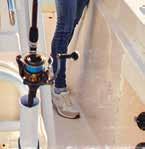



Maine’s beauty invites adventure and stirs the soul.
It’s where rocky cli s meet sandy beaches, and vast forests stretch toward crystal-clear lakes. Here, you don’t just explore the land.
You forge a deeper connection to it—and to yourself.














the only lines are the ones behind you.






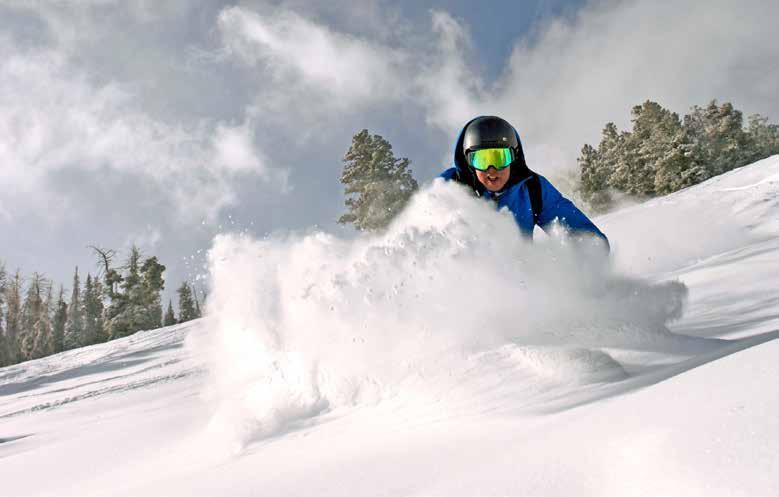
Welcome to the overhauled and re-issued Mountain Life! It’s got all the glorious skiing and outdoor adventure content you’ve always loved from us, but now has some extra flavours: more culture, more local heroes, more community builders, more must-know environmental news and more real life—mountain life, Ontario style. We’ve also expanded our Mountain Homes section—because the base camp for our adventures is home—and created a new section, Trippin’, containing near and far destinations worth telling you about. We’re celebrating and promoting local events. A vibrant community has an active night-life— from live music, to comedy, to grand openings, to charity dinners and galas. If you have an event you’d like us to cover, send me an email at david@mountainlifemedia.ca.
Our focus is on Southern Georgian Bay’s mountain lifers—we ski, we mountain bike, we buy season passes at Blue, we’re members of private clubs, we purchase real estate, we love nature, we’re heavily invested in our region and we spend thousands every year on recreation because that’s congruent with our values. We also work and live here, raise our families—driving our kids to music lessons and rugby practices—and get out on the water or in the forest to recharge.
I’m very happy to be back in publishing, after a brief hiatus. I’ve now worked as publisher of more than half of Southern Georgian Bay’s top local magazines, and I’m happy to say I’m finally at the place I belong. Mountain Lifers are my people.
The magazine industry, especially locally, is not only alive and well, but thriving. When was the last time you’ve actually really enjoyed consuming content on your phone or iPad? I get social media fatigue, personally. Anytime I open an app, or load a website for an online publication, I’m bombarded with pop-up ads I can’t get rid of fast enough. Magazines are calming—a break from the digital noise bombardment—and places of carefully designed and curated content. You consume at your own pace. In Mountain Life’s case, this content is brought to you by industry leaders, journalists and Canada’s top photographers, all with incredible talent for capturing the spirit and essence of our outdoor lifestyle here in Ontario’s adventure capital. We take this responsibility to heart.
There’s so much great content to consume in this edition. I hope you enjoy it, and I hope you stick with us for the years ahead—because we’re going to continue to show you how alive and well the magazine industry really is up here, and we’re going places.
Cheers,
Dave Loopstra



Glide the groomed trails
Ride winter f at bikes
Ski c ross-country classics
Stomp snowshoe tracks
Explore f amily adventures
Learn in group outings
Step into Winter Scan to Explore




operates within and shares stories primarily set upon the traditional lands and treaty territory of the Anishinabek Nation. We acknowledge and celebrate the past, present and future People of the Three Fires, known as the Ojibway (Chippewas), Odawa and Potawatomi Nations, who lead us in stewarding these lands and waters, and we honour their knowledge and cultural ties
david@mountainlifemedia.ca glen@mountainlifemedia.ca
todd@mountainlifemedia.ca glen@mountainlifemedia.ca
david@mountainlifemedia.ca
amelie@mountainlifemedia.ca
tara@mountainlifemedia.ca
ned@mountainlifemedia.ca
allison@mountainlifemedia.ca kristin@mountainlifemedia.ca colin@mountainlifemedia.ca scott@mountainlifemedia.ca
DIRECTOR OF MARKETING, DIGITAL & SOCIAL Noémie-Capucine Quessy noemie@mountainlifemedia.ca
FINANCIAL CONTROLLER
Krista Currie krista@mountainlifemedia.ca
DISTRIBUTION
Glen Harris glen@mountainlifemedia.ca
Brendan Thompson brendan@mountainlifemedia.ca
Distribution Inquiries david@mountainlifemedia.ca 705-445-3392
CONTRIBUTORS
Leslie Anthony, Feet Banks, Jessica Carnochan, Melanie Chambers, Sarah Chisholm, Geoff Coombs, Matt Cote, Alain Denis, Taj Field, Kath Fudurich, Chris Guibert, Justin Johnston-Jewel, Dean Heliotis, Mitchell Hubble, Jenna Kitchings, Jeff MacInnis, Carl Michener, Mark O'Grady, Nadia Pestrak, Kianna Sunshine, Savannah Stephen, Will Tam, Tom Thwaits, Leslie Timms, Scott Turnbull, Kyle Wicks, Jody Wilson.
SALES & MARKETING
David Loopstra david@mountainlifemedia.ca 705 445 3392
Glen Harris glen@mountainlifemedia.ca 705 441 6334
Bob Koven bobby@mountainlifemedia.ca 416 721 9940
Mike Strimas mike@mountainlifemedia.ca 416 779 7908
Ashley Warrington ashley@mountainlifemedia.ca 705 888 2456


P. 58 A Family in Motion: The Honeywood-Burk Crew
P. 76 High Country Fix: Aspen CO’s Inspirational
Affordable Housing Solution
P. 92 Stride On: A Long-Running Pastime
P. 53 Gear Shed: The Latest Fall-Winter Schwag
P. 69 Mountain Home: Ravenna Ridge House
P. 86 Travel: Not Your Grandparents’ Club Med
P. 99 Mountain Lifer: Paul Woolner’s Waves
P. 102 Photo Gallery
UPFRONT
P. 20 A Gift of Creation
P. 22 Spreading the Word
THE MOUNTAIN LIFE - EVENTS
P. 24 Hometown Hall
P. 26 Art & Real Estate in Collingwood
P. 28 Everlove Festival
P. 30 The Milkbarn + Live Music Update
TRIPPIN’
P. 33 Day Trips: Fall Paddling, South Bruce, Creemore’s Small Halls
P. 34 Day Trips: Lovebird Brewing Co.
P. 36 Road Trips: Tremblant
P. 39 Road Trips: Mount Bohemia
BETA — NEWSWORTHY
P. 42 Drilling the Bay, Castle Glen Update, The Talisman Tangle, Collingwood Hospital Fundraiser, Women’s Alpine Experience at Blue
APRÈS
P. 112 Community-Builder Sean Rennie





We all enjoy this paradise we call home: it’s what Mountain Life celebrates. The rivers, forest trails and beaches across the province all provide limitless bounty for locals and visitors alike within the perennial abundance of each season. These lands and waters are the life-givers that nurture mind, body and soul.
A little reciprocity goes a long way in giving thanks for this region of abundance and understanding our place in it—and our relationship to it.
Saukiing Anishinaabekiing to the Anishinaabeg since time immemorial, the heartlands across Grey and Bruce counties were opened for settlement by the British Crown in the mid-1830s and experienced rapid colonization starting in the early 1850s. It is a landscape hewn with human stories, surrounded by natural wonders.
This past summer the Saugeen Ojibway Nation (SON) Environment Office (EO) was made aware of the existence of a dumpsite on Lyal Island, Lake Huron. The largest and northernmost among the chain of islands known as Gigoon-kawa-mnising (the Fishing Islands in Anishinaabemowin), Lyal spans over 750 acres and rests 2 kilometres across Stokes Bay, off the west coast of the Saugeen Bruce Peninsula. Critical atikameg (lake whitefish) spawning beds lie in close proximity.
A generous stash of disintegrated marine-grade lead-acid batteries (almost 80 total)—as well as lead paint cans and other hazardous metals, heaps of broken glass and plastic debris—had been lobbed into the forest of predominantly eastern white cedar, a few hundred metres from the lightstation navigation tower.
Managed by Fisheries and Oceans Canada (DFO) and maintained by the Canadian Coast Guard (CCG), the steel light tower at Lyal was installed in 1973, replacing an old wooden lighthouse originally built in 1884 and automated in 1959.
The batteries had been tossed to the moss decades ago. But that’s really just the pinky finger. Every other finger and a couple of
thumbs represent each decade that followed while the hazardous debris was left to fragment and slowly ooze into the watershed.
A 2022 report concluded that an estimated 665 tonnes of soil at the site have since become contaminated with lead and zinc.
The report also advised a long-term remedial action plan (RAP) to chop down the forest and excavate the contaminated soil—a heavily extractive operation that was slated to go to tender in 2026/27.
The report revealed the DFO/CCG have known about the environmental contamination at the site since at least 2001.
Over the course of three days in early September, the Three Waters Foundation, a local not-for-profit waterguardian organization, orchestrated a careful removal of the hazardous waste—after the SON EO stated a request to have it removed by the end of September and the DFO/CCG stating they wouldn't meet the timeline. A sum total of a little over 1 tonne of decaying lead batteries, lead-paint cans and other hazardous metals were removed from the forest floor.
Supporting Indigenous-led stewardship and sovereignty by notifying band offices when you come across anthropogenic debris found within the territories can have a meaningful impact on the ecosystem. If you are a resident of Stokes Bay, you can thank the SON EO for holding the DFO/CCG accountable and supporting the removal of a longstanding source of contamination. The DFO’s longterm RAP for the site now has to be approved by the SON EO, so the eastern white cedars won’t be cut down anytime soon and a more holistic RAP will be implemented that accounts for the non-human relatives too.
These wild spaces are truly a gift of creation. Taking care of them is our shared responsibility, and there are organizations that can help. Supporting initiatives that protect our rivers, forest trails and beaches can help us preserve the balance and abundance for generations to come. –Scott Parent

Stopping invasive species starts with how you manage your outdoor play
These days, hardly a week passes without an invasive species story catching your attention. That’s because the proliferation of introduced non-native species that become problematic in some way—the basic definition of invasive—has been turbocharged by increased travel and trade in our globalist society.
It’s not just lamprey in the Great Lakes anymore, but round goby, grass carp, quagga mussels and a broad range of other invertebrates and plants. On land it’s a gumbo of feral pigs, emerald ash borer, buckthorn, garlic mustard and the scourge of phragmites (European common reed) choking out Ontario’s shorelines and wetlands.
With the latter, you’d have to be as old as I am to remember when it didn’t exist in Ontario. Today’s vast stands of “phrag” aren’t just a nuisance, but an ecological disaster that decreases plant biodiversity, provides poor habitat and food for wildlife, grows quickly enough to lower surfaceand groundwater, increases fire hazard
and affects agriculture, road safety and recreational activities.
That’s a lot of nasty for one plant, and, sure enough, millions are spent on phrag’s removal. Millions more on a six-year-running biocontrol program involving insect enemies from its native range. Attacking both ways is key because the plant reproduces both by aggressive rhizomes and abundant seeds that spread naturally. The biggest problem is the rest of us, who, undermining these costly programs, unconsciously aid the spread of invasive plants by moving seeds and root fragments around. What to do?
Well, perhaps you’ve heard of “PlayCleanGo—Stop Invasive Species in Your Tracks,” a campaign aimed at preventing detrimental effects of invasive species to North America’s lands and waters. Most relevantly, it educates outdoor recreationists on how we unknowingly contribute to this. Seeds and plant fragments can stick to mountain bikes, dirtbikes/ATVs, shoes, clothing, backpacks, horses and dogs to be subsequently spread to new areas and trail

networks—harming the very areas we enjoy. As a result, PlayCleanGo is a sort of Smokey Bear call-to-action: Only YOU can Prevent the Spread of Invasives!
It boils down to adopting a few general habits: removing plant bits and mud from boots, gear, pets and vehicles; cleaning gear before entering and leaving a recreation site (like, say, shaking out your tent) or moving to a new area; sticking to marked and designated roads and trails so that any invasive transport is at least localized; and, because it can carry incredibly destructive insect pests, using only certified or local firewood. Hay, a prolific source of invasive insects and plant seeds, is another notransport caution (though I’m not sure what you’d use it for other than a barn dance).
Footwear, of course, is the most insidious vector, requiring hikers, trailrunners, dog-walkers, mountain bikers—even cavers—to pay heed. Did you know the fungal plague of white-nosed syndrome that wiped out over 6 million of eastern North America’s bats was introduced from Europe to a cave on this continent by a hiking boot? Clean yours before and after at the boot-brushing stations found at many trailheads, or carry a small, stiff-bristled brush in your backpack.
With paddling and boating, PlayCleanGo shifts to CleanDrainDry. Clean off visible aquatic plants, animals and mud from watercraft, gear, paddles, floats, ropes, anchors, dip nets and trailer before leaving water access, and rinse inside and out and scrub the hull. Drain watercraft, sponges, bailers and any water-containing devices and allow them to dry five days or more when moving between waters. Fishing cautions are similar, with the addition of disposing of unwanted bait and packing materials in the trash instead of dumping them in water or on land—a practice that has introduced numerous invasive earthworms, crayfish and minnows to Ontario.
Many Ontario municipalities and communities in cottage country and around the Great Lakes have PlayCleanGo weeks in summer to help raise awareness of invasive species. But why not get ahead of the game and make it part of your own outdoor routine?
–Leslie Anthony










































When Hometown Hall swung open its doors in downtown Thornbury, it wasn’t just another venue launch—it felt like the town got a brand-new heartbeat. The grand opening pulsed with energy: laughter rolling through the crowd, locals shoulder-to-shoulder with the weekend wanderers and the echoing cheers of excitement during the mug membership auction.
Behind the bar? Taps were flowing with the bold, session-worthy lineup from Son’s Brewing. Crisp lagers and a crushable IPA fuelled the energy late into the night. Pair that with local eats cider, and good times, and you’ve got an evening that hollered, “Come on back!”
The space is heartwarming—with its old-school charm and backroad feel—the kind of place where they still play classics by the Dixie Chicks and John Denver on a Friday night. A massive gallery wall anchors the room, stacked with vintage posters, family photos, old hockey shots and sentimental memorabilia—a patchwork of local history that sparks conversation before the first sip. It feels like you’ve stumbled into a true hometown scrapbook, only with a sweet patio and even better beer.
Hometown Hall isn’t just a bar and Son’s Brewing doesn’t just make awesome beer— they have created a scene, a gathering place and a must-hit spot when you’re looking for cold beer, light snacks and nice folks. hometownhall.ca –Ashley Warrington

COLLEGE & UNIVERSITY
Lift Tickets $69*
MONDAY TO FRIDAY
When campus chaos peaks and your brain’s ready to bail, it’s time to trade cram sessions for chairlifts. Take a study break that actually works — carve it out on the hill and come back clear-headed.
*Price

Collingwood just levelled up its cool factor with the grand opening of REVEL Realty Inc. and the Jen Scholte Real Estate Team space—and trust us, this is not your average real estate office. Opening night felt more like an art gallery launch party: music spilling into the street, glasses raised and a crowd blending council members, artists and excited locals.
Inside, the vibe is pure inspiration. Art installations from local talents like Marija Bacic Main fill the walls—familiar, bold, vibrant and alive with the energy of Georgian Bay. Wander upstairs to the onsite art studio and you’ll find Alison Boyack, another cool local artist, paintbrush in hand, keeping the creativity flowing and giving the space the feel of a living, breathing gallery.
REVEL isn’t only an office with a team of next-level realtors—it’s an art lover’s hangout. A spot to slow down, take in the space and explore Collingwood’s downtown art scene. It’s where real estate meets culture, and where the town’s creative spirit is on full display. revelrealty.ca –ML Staff







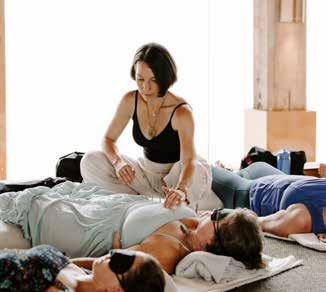
words & photos :: Kianna Sunshine
Every mountain lifer knows that the secret to being your best on the mountain bike trail, climbing wall or in the glades means recharging and taking care of your body. Thankfully Southern Georgian Bay is home to some of Ontario's finest wellness practitioners, with the wellness studio and hub Everlove leading the way.
Everlove Festival isn’t just a wellness weekend—it’s a reawakening. Nestled amid the Blue Mountains’ natural beauty, it draw together seekers, teachers and curious hearts for transformative days of sweat, stillness and connection. These moments—raw and real— remind us that wellness isn’t a solo journey, but one best shared.
The next Everlove Festival is a one-day event taking place this November 15. Don't miss it. everlovefestival.com















Driving down a long and potholed driveway to what looks like a haunted farm feels like a trek into an old horror movie. Big silos point to the sky, and an abandoned house looms next to overgrown Manitoba maples. But don't be fooled. This is the headquarters of Collingwood's newest improv (aka: jam band) and live music scene, regularly hosting some of Ontario's hottest up-and-coming bands. The driveway turns, and the scene becomes very friendly, with music lovers hanging out in a grassy field parking lot. This is the brainchild of Kyle Haight, a local musician and artist, and his partner Mel Sheridan.
They've been hard at work, cleaning out the old farm space— which was full of trash when they took it over—and revealing it as the spectacular property it is. They’ve created a warm and inviting venue to celebrate music late into the evening, in a place where everyone is welcome. The Milkbarn itself is an old barn on one of Collingwood’s oldest farm properties, in the shadow of Blue Mountain. In the barnyard, a large stage stands beneath the huge, lighted silos. There are lights strung in the trees, art installations, and a giant fire pit. Inside the barn is another stage and a lounge area set up to host bands and fans. There's even a green room.
"The Milkbarn is the venue as art," says Haight, who has turned a lot of the trash he found on the property into clever and amazing works of sculpture art. The idea to create the Milkbarn, he says, came one evening when he took some natural supplements and had some visions—some wisdom speaking to him from the trees and spirit animals. Since then the Milkbarn has grown into a huge community, and the huge amount of work necessary for its completion is nearly done. “Then I can use the Milkbarn for what I created it for, which is a space to be creative,” adds Haight. It is a special place, giving rise to incredible moments for Collingwood’s music lovers. Legendary bands from Ontario's jam-band scene have played here—Zuffalo, Must Stash Hat, Cherry Garcia, Molecular (Haight’s band), Voodoo Sometimes, Glacial Erratic, Aster Nox, Shapes, Orbit, Petrichord and many more. Every second weekend in August, the Milkbarn hosts a three-day festival of amazing musicians, including bluegrass outfits, singer-songwriters, rock bands and yes, lots of jam bands.
Follow @MilkbarnSessions on Facebook to learn about upcoming shows and festival details. –ML Staff
AVENING COMMUNITY HALL, AVENING
Nov. 15 Joel Plaskett
Nov. 18 William Prince
Dec. 4 Hawksley Workman + lots more: aveninghall.ca
MEAFORD ARTS AND CULTURAL CENTRE, MEAFORD
Nov. 1 Ashley MacIsaac
Nov. 14 Long Live: An Unofficial Taylor Swift Tribute Band
Nov. 27 Skydiggers
Dec. 12 Celtic Tenors + lots more: meaford.ca/meafordhall
VILLAGE AT BLUE, BLUE MOUNTAINS
Oct. 14 to Nov 14
Nov. 15 to Jan. 3
Nov 16 and 30
Fallicious
Holiday Magic; festive lights, decor, live music, themed weekend entertainment, Santa sightings, sleigh/carriage rides, DJ series and more.
Jesse Murphy + lots more: bluemountainvillage.ca
CORNER CAFE AND GRILL
Weekly
Free and awesome live music on weekends and open mic every second Tuesday.
FRONTIER GHOST TOWN, DURHAM
Nov. 1 Tell It To Sweeney, Glacial Erratic and Mista Twista
MILKBARN, COLLINGWOOD
Nov. 1 Must Stash Hat with Hot Fix and Gringo Funke
BLACK BELLOWS, COLLINGWOOD
Nov. 1 DJ Limoncella
Nov. 29 Glacial Erratic with Hot Fix
FOUR WINDS MUSIC FEST AND THE HAPPINESS MAFIA (various venues) See @fourwindsmusicfest
Oct. 17
Danny Michel
Nov. 1 The Sadies & ONTARIANS
Nov. 8 Jolie Anastasia’s Record Release
HAVE AN EVENT YOU’D LIKE US TO COVER? Send us an email at mlbm@mountainlifemedia.ca











“We lead with heart, purpose, and an unshakable belief in building something bigger.”
From the vibrant streets of Collingwood, rolling hills of Simcoe, Dufferin and Grey Counties, and the sandy shores of Georgian Bay, REVEL Realty Inc. Collingwood REALTORS® help people live the lives they’ve always dreamed of.
We’re not just real estate professionals, we’re coaches, collaborators, and lifestyle ambassadors. We’ve built a brokerage culture where agents thrive, clients feel heard, and moves are just the beginning of lifelong connections.
In a market shaped by nature and powered by community, we do more than guide transactions. We lead with heart, purpose, and an unshakable belief in building something bigger.

This isn’t just a place to visit. It’s a place to stay. Join the REVELution.

Jen and Mike Scholte, REALTORS® and Head Coaches
“Our lives need the relief of the wild at the edge of town.” —Henry David Thoreau
There will be days in November when you need a little relief. Nothing frees the mind and buoys the spirit like getting out of the house and venturing down the road. Luckily for us, our towns and destinations are just around the corner at the end of absolutely stunning drives. Here are a few quick suggestions to get you started for an afternoon—and a couple of top-notch (or, in the case of Mount Bohemia, "overlooked") destinations worth the spectacular drive.
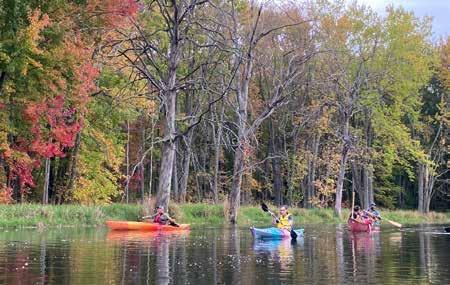
Looking for an afternoon adventure close to home? Book a river paddle among the fall colours with Free Spirit Tours. This well-established tour operator offers canoe and kayak rentals and shuttles on both the Beaver River and the Nottawasaga River. Both routes are suitable for beginner to experienced paddlers. Paddling runs until at least Thanksgiving, but if beautiful autumn weather continues, Free Spirit will extend the season well into October. “It’s the best time of year to paddle our local rivers. Between the fall colours and no bugs, why wouldn’t you want to be on the river?” says Free Spirit owner Jennie Elmslie. (And when the weather turns cold, Free Spirit offers all-season caving tours as well as hiking, snowshoeing, forest therapy and more.) Check out freespiritours.ca to book online or call ahead to reserve your boat and shuttle.
PRO TIP: Sections of the Beaver River south of Heathcote flow through a mature sugar maple forest (yes, the river runs through it—right underneath and around the trees). So your fall colour tour this year should include a canoe. Be prepared to have your mind blown.

Summer is in the rearview mirror but that doesn’t mean your beach days have to end. Fall is an ideal time to visit the town of Sauble Beach and the endless white sands of Saugeen Beach. The crowds are gone, the dunes are peaceful and there are still plenty of local gems open. Stay at The Sands Hotel, Sauble’s newest fourseason hotel with a rooftop patio, grab dinner at The Dunes (the BEST karaoke on Saturdays; never a cover charge), pick up a surfboard rental from Jack and Jill’s (fall brings the big waves) and stop by Sauble Falls Provincial Park to hike, paddle or watch the fish jump. Then take a drive to Wiarton and visit the thriving downtown, Bruce’s Caves nearby, or the Spirit Rock Conservation Area. Find out more at destinationsouthbrucepeninsula.com or explorethebruce.com
PRO TIP: West and northwest winds mean big waves. If you own a surfboard or paddleboard, watch your Windfinder app for the beauty hour when the big winds die but the waves clean up and keep on rolling in. Make sure you pay for parking—they patrol.

Every September to November, the village of Creemore holds the awardwinning Small Halls Festival Series. These community halls and venues are the heart of Clearview Township. These are the storied places where your cousin got married and your grandpa hosted his retirement party. Now you can experience a lineup of performers and theatrical experiences, including Jamie Williams Concert and Dance, the Elbows Up Whisky Night, The Time Capsule, the Amazing Race Afterparty, Songwriters That Rock and Sohayla Smith. Fill your fall with live music, laughs and community spirit. Get all the info at smallhallsfestival.ca
PRO TIP: And there’s so much more to Creemore. Road bike? Gravel bike? This has to be your destination. Buttertarts? Beer? Patios? It’s all here, after the most satisfying road ride of your life. Follow @discoverclearview and @creemoreontario for more.
–ML Staff
words & photos :: Ashley Warrington
I just found the perfect spot to roost in Meaford: Lovebird Brewing Co. What started as a dream between Al and Emily has taken flight into one of Georgian Bay’s most exciting new spaces. Making that vision real? The Straw Hat Renovation crew. These design rebels, known for their meticulous craftsmanship, created a place that focused on community, comfortably familiar and designed to make new friends and lasting memories.
Walking in, I was struck by the rad retro-cozy vibe—warm wood, exposed brick, vintage touches—and behind the custom-made bar, a legendary crew you immediately want to hang with. The taps gleam with small-batch brews as thoughtfully crafted as the space itself. I kicked things off with the Birdweiser, a smooth, light lager that’s both refreshing and full of character. Fresh from the kitchen, Belle Marche’s East Coast-inspired eats, delivered right to the table by Chef Ryan, were impossible to resist—ask him which dish is best, and he’ll tell you all of them, and he’s right!
By the time I left, the sun had dipped low, the beer glasses were empty and I realized this wasn’t just another brewery—it was a vibe, a hangout, a Meaford rite of passage. And honestly? I’m already plotting my next flight back.


@lovebirdbeer @belle_marche_meaford @strawhatrenovations








A few days at Tremblant just scrapes the surface
words & photos ::
Kristin Schnelten
My balaclava and cheek have become one, frozen together in a steadfast fight against the biting wind. Dampness is the enemy of the balaclava, and today I have it in spades. Try as I might, there’s no way to avoid an exhale—but it’s the tears that sealed the deal.
And I don’t care. Those were happy tears, and I’ll gladly shed them again. We’ve spent the morning zooming over corduroy beneath bluebird skies, chasing our mountain host from one side of the mountain to the other, my daughter hot on my tail and often in my periphery. Rarely have I felt such a sustained rush of pure glee.
The piles of luggage, the white-knuckle drive, the slogging of gear—it all melts away as easily as that icy fleece when we step inside for hot cocoa. Why is skiing so magical? And why is that magic shimmering so close to the surface at Tremblant?
Our host this morning is Sylvie, who’s chattering away about
the history of the resort and her favourite runs. She spies my watery eyes and commiserates, “It’s impossible to be at Tremblant and not be happy.” And I dare say I believe her.
We’re here for a quick mid-week trip, hoping to get a taste of this storied resort and its joie de vivre. And—from the walking village dotted with historic Quebequois buildings at the base to the are-yousure-we-aren’t-in-Innsbruck cobblestone plaza at the top—it’s safe to declare we are enchanted. Twitterpated, even.
My daughter and I ski now-favourite runs, stopping for extra hand heaters, willing the day to last just a couple hours longer. We take the wide, meandering, 6-kilometre Nansen back to our hotel, a run that easily takes the crown for greatest beginner run east of the Rockies, with views of the Laurentians stretching beyond the horizon.
After another mwah! village dinner (Ôwok tonight, A Mano yesterday), we challenge a young Connecticut family to a thrilling game of laser tag—a sprinting, gasping 15-minute scramble that


awakens a competitive beast heretofore slumbering and finds me pleading again and again for just one more game.
Dawn arrives, and with it the snow. All the snow. It dumped overnight, and it will continue throughout the day. Yesterday’s views are socked in, but no matter. Today we’re headed down the road a piece, away from that powder but toward the yowling and howling of six ecstatic dog teams, desperate for their sleds.
The twisting corners are exhilarating, the snow is ludicrously deep and our hoots intertwine with the dogs’ yips, floating up through the tall pines. We pat panting heads and slurp more cocoa by the fire, then head back to the hotel to suit up for a trail run on our own two feet, discovering a softly lit path that leads across the mountain and through a storybook canopy into the woods.
“It’s impossible to be at Tremblant and not be happy.”
After an evening punctuated by piles of tiramisu (our third dose of the trip) and belly laughs echoing through the village, a night beneath crisp duvets and a breakfast we could barely finish, we reluctantly repack the truck. There’s just so much left to experience (and so many powder turns to make). We make a final lap around the village, bidding Tremblant au revoir, but not adieu.








The more plentiful the stickers, the cooler the place
words :: David Loopstra
“Places like this, they’re rare,” says Tony, the ski patroller with the curled moustache and chill demeanour (wait, that describes most of the ski patrollers here, along with mullets and plaid). “They don’t exist anymore.”
It’s true. Thirty years ago, the art and culture of ski-bumming was alive and well, and people did it right. They lived in the overflow parking lot in vans or buses fitted with wood stoves—or they camped in the backs of cars. Some tented (ha!). Others rented houses in town with buddies. At least, that’s how I did it, and since then I’ve dreamed about doing it again.
“But you don’t see this really that much anymore.”
Tony is, indeed, conversing with me inside a bus fitted with a wood stove at the legendary, fabled Mount Bohemia in Michigan, the raddest ski hill between Ontario and the Rockies. We are drinking fine craft beer from the nearest town, while outside the full moon glows upon the wilds of this last outpost—the farthest point of land you can drive to in the middle of Lake Superior. Tony is a thoughtful dude, and he waxes poetic about history, culture, geography and stuff I always find super interesting after smoking (legal in Michigan) weed and chilling with
truly dedicated ski-bums who love to shred rad glades all day. “Yeah, true ski culture is alive and well here,” Tony continues.
And suddenly I truly realize just what a treasure this place is— jutted way up Michigan’s Upper Peninsula. I had stumbled upon a skier’s dream come true. Not only is it rad, it has culture.
Here are some facts:
Annual snowfall 273 inches. That’s over 22 feet.
Skiable Acres 585
Vertical Drop 900 feet
Runs 111
Terrain Natural half-pipes, glades, chutes, tree-lined runs, powder puffs and CLIFFS!
It’s extreme, baby. I think I only saw one blue run. Everything is double black or triple. No grooming. They have a giant sign that says “No Beginners.”
Get this: A season’s pass—early bird—is $99. Ninety-nine dollars. Sure, that’s USD, but c’mon! Plus, their pass works at a TON of partner resorts from Idaho to Quebec.





Nine hundred vertical feet is more than good enough. Go anywhere—Revy, Whitewater, Vail, Fernie, Tremblant—and try skiing more than 600 vertical feet on a pow day without taking a quick li’l breather. Nine hundred vertical feet is plenty. The terrain is sprawling and big. Picture an upside-down bowl, and you have the shape of the mountain. There are no flat zones, and you can ski any side ‘til your heart’s content—or at least until the two lifts close at 4:20 (genius).
“Yes, you can go anywhere,” says Lonie Glieberman, Mount Bohemia’s owner and visionary who purchased the resort in the late ‘90s after hearing about the opportunity from a guy on a chairlift in Colorado.
Lonie learned that a previous developer had ambitions to build a resort on the mountain, but nothing had come to pass. Lonie was coming off a stint as the president of the CFL’s Ottawa Rough Riders, and was in a mid-life questioning period—also recovering from mild PTSD thanks to unforgiving newspaper sports writers. “I remember saying to a girl I was talking to, ‘I have no idea what I’m going to do with the rest of my life.”
Until that fateful chairlift ride.
“Yeah, that was before the internet, so to find out more information I had to go down to Barnes and Noble and get a book on the [Michigan] Upper Peninsula and sure enough, there it was.”
Fast forward a few years, and Lonie had picked up couple of used chairlifts from Quebec, and had started building the lodge and bar—think big log cabin, very cozy. He created incredible glade skiing, and hired patrollers to keep everyone safe. Then came the spa—he’s adding to it every year, with Himalayan salt saunas, Finnish saunas, a couple of hot tubs, a big heated swimming pool, steam rooms and cold plunges.
“The original proposal [before Lonie] was modelled after Blue Mountain Resort,” Lonie continues. “But that’s two hours from Toronto. Mount Bohemia is five to ten hours from the nearest big centre. Big difference.”
Lonie knew he needed to make it special. He needed to make it rad. He needed to highlight its natural characteristics and appeal to true skiers. Now there’s pizza, and a second bar and one hell of a party scene.
“This is a poor man’s Japan,” says Joe Christiansen, a whitewater raft guide in the summer and liftie in the winter, living in a camper (sometimes a tent too) in the parking lot. He’s referring to the gobs of snow that Japan is renowned for. Joe is also revered by many as one of the raddest skiers on the mountain, along with his girlfriend Leigh. I’m lucky enough to follow him around for a couple hours while he hucks cliffs in the soft spring snow.
It is indeed spring. And normally this late in the season back home, I’d be far away from the hill—looking for dry dirt on my mountain bike, or paddling or something. I’d have definitely given up on winter.
But people here are stoked.
Leigh and Joe are stoked. Tony is stoked. I am stoked. I told Leigh I was, and for that, she handed me a sticker.
“If someone says they are stoked, I give them a sticker,” she says. And I’ve found that in the US, the radder and more plentiful the stickers, the radder the spot. There are stickers everywhere here. On the chairlifts, on the doors, on the ski racks, on people’s helmets, on the shuttle that takes you back to the resort from the back side. It’s a rare place, a skier’s paradise. And it’s full of stickers.





TC Energy’s offshore drilling near Meaford raises concerns for Georgian Bay’s fragile ecosystem
Last August, an unexpected sight appeared on Georgian Bay: a drilling rig stationed offshore near the 4th Canadian Division Training Centre outside Meaford, known locally as “the base.” Owned by Burlingtonbased McKeil Marine, the temporary structure has caught the attention of residents and environmentalists alike. It’s not just a piece of industrial equipment—it’s the first visible sign of TC Energy’s controversial pumped storage project, currently in its feasibility phase, for which Ontario taxpayers are investing up to $285 million for environmental assessments and cost estimates. While the goal is to collect data for a potential 1,000-megawatt open-loop power system, the environmental impact is already raising alarm bells among critics.
TC Energy says the project, proposed to be built on the base property, essentially works like a giant battery. During offpeak hours, when electricity is available at a reduced price, water is pumped from Georgian Bay uphill to a proposed 375-acre reservoir at the top of the escarpment, which TC would construct. Then, during peak demand—when electricity prices are higher— the water is released through electricitygenerating turbines back to the bay. Critics point out that similar models have resulted in roughly a 25 percent loss in energy, but proponents say that the off-peak energy used to pump the water uphill is put to better use this way.
Georgian Bay is known for its clear, deep waters, rich biodiversity and fragile
ecosystem. It’s a natural habitat for a diverse range of species, some of which are endangered. The drilling is part of TC Energy’s ongoing geotechnical program, aimed at determining the suitability of the lakebed for the proposed storage system. To get this data, the company is drilling boreholes deep into the lakebed. This process involves drilling narrow, deep holes to investigate subsurface conditions. However, critics say that drilling in such a delicate environment comes with serious risks—risks that many local residents and environmental experts are concerned about.
Tom Buck, a longtime member of the Save Georgian Bay group, warns that even with environmental safeguards, this process could have unintended consequences. “You can’t drill into a lakebed without disturbing it,” Buck says. “There’s no way that rig, with its fuel and lubricants, isn’t introducing contaminants into the water. This is an indication of how they’re going to treat the bay, and it’s a real concern for the long-term health of the bay.”
Buck points out that as the rig drills into the lakebed, there’s a high chance that sediment is being disturbed and stirred up, potentially affecting the surrounding water quality. His concern is that if the process contaminates the lakebed sediments, aquatic life and water quality could be affected. He says the impact on fish and other wildlife could be significant, especially when considering the bay’s status as a vital source of drinking water and a key ecological area.
According to Buck, this kind of industrial activity is out of place in such a pristine environment. “This area has been largely untouched. Once you start drilling and introducing these foreign elements, there’s no going back.”
TC Energy, however, defends their activities. “The offshore geotechnical investigations currently underway are being conducted with rigorous environmental safeguards and strict adherence to federal and provincial regulatory requirements”, wrote TC Energy’s communications lead Sara Beasley in an email to Mountain Life. “Protecting Georgian Bay remains a top priority throughout all phases of project development.”
The drilling is expected to last for a few months. Once completed, TC Energy’s feasibility studies will be used to determine the future of the pumped storage project. If the project moves forward, it could result in a large-scale alteration of the shoreline north of Meaford, say critics. The potential for further ecological disruption, coupled with the unknown effects of years of construction and operational activity, has local residents worried about their water, property values and way of life.
Even though TC Energy assures the public that every measure is being taken to safeguard the environment, Buck remains skeptical. “They claim to be offering a clean, green solution to Ontario’s energy needs,” he adds. “But what they’re actually doing is creating long-lasting harm to an irreplaceable ecosystem.” – Colin Field




As Ontario’s real estate market slows, environmental advocates see a rare opportunity to protect a big parcel of wilderness south of Blue Mountain

It’s been more than 20 years since Castle Glen’s massive development proposal of up to 1,600 residential units, hundreds of hotel units, three golf courses and thousands of square feet of commercial space. But today, that vision looks more like a relic of a different era. With no new plans submitted— and The Globe and Mail reporting whispers of layoffs at development company Great Gulf—the Escarpment Corridor Alliance (ECA) hopes this long-contested property might finally have a chance at protection.
“This is a key piece of land in the escarpment corridor,” said Stephen Griggs, cofounder and chair of the ECA. “It’s 1,532 acres right in the middle of the corridor we’re trying to stitch together. It’s ecologically significant, home to wetlands and potentially species at risk. And nothing has happened there for years.”
Well, almost nothing.
The ECA continues weekly monitoring and ecological fieldwork along the perimeter of the property. But from the developer?
Crickets. There’s been no public engagement, no updated proposals and no participation in the Town of Blue Mountains’ servicing plan.
According to Jarvis Strong, executive director of the ECA, the economic climate may be doing what decades of environmental activism couldn’t: slowing down, or even stopping, what he sees as inappropriate development.
“The whole economic viability of resortstyle properties is in question,” he said. “I talk to people in the GTA real estate world and they say it’s a disaster—projects are being sold off by receivers. So even if a developer got all the necessary approvals, would it be economically feasible to build?”
Add to that the massive costs of water and sewage servicing—which currently don’t exist at Castle Glen—and the business case for building becomes murky at best.
While no one from the developer has publicly pulled the plug, Strong and Griggs see an opening.
“In a perfect world, the land would be protected in its natural state,” said Strong. “Ideally, it could become part of Pretty River Valley Provincial Park, which is just a couple farms away. But even if not a formal park, some form of permanent conservation would be the goal.”
They’re exploring a range of scenarios, from land acquisition to eco-gift donations. But with a rumoured purchase price north of $60 million, it’s no small task.
Both Strong and Griggs are quick to note: they’re not anti-development. “We’re pro–smart development,” said Griggs. “But when something is inappropriate in scale, location, and purpose, we have to speak up. Castle Glen is all three.”
For now, the best thing that could happen to this stretch of forest, escarpment and wetland might just be nothing at all. In the face of economic headwinds, inaction could be the Castle Glen property’s saving grace. – Colin Field

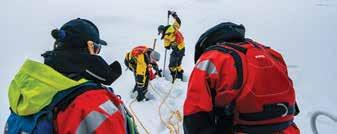




Dates: January 8-19, 2027 Ship: MS Fridtjof Nansen Departure: Buenos Aires, Argentina
Patricia Bootsma P:416-367-8264 ext. 2023
E:trish.wiredfortravel@gmail.com wiredfortravel.com



What’s really going on with Ontario’s most contentious former ski resort property?
Talisman has always meant something different to everyone. For some, it was the ski resort where they first linked turns. For others, it’s a ghost of alpine ambition left to rust in the hills. But in recent years, this iconic Beaver Valley property near the village of Kimberley has become a flashpoint in the ongoing fight over what kind of development belongs in Ontario’s Niagara Escarpment.
I recently sat down with local conservation group, the Escarpment Corridor Alliance (ECA)—specifically Stephen Griggs and Jarvis Strong—to get a clearer picture of where things stand. The short version? It’s complicated.
The land that once made up the Talisman resort is now split between two owners. One is the Beaver Valley Development Group (BVDG), which owns the former golf course lands and a plateau just west of the brow. The other is a separate group—composed of Phil Calvano and Brian Ellis—that holds the former hotel and ski hill property.
Together, they technically control what
used to be a single resort. And that’s one part of the complicated problem.
Back in 2022, BVDG submitted a subdivision plan to Grey County that proposed 280 townhomes and 90 apartments on the old golf course. But the Niagara Escarpment Commission (NEC) issued a detailed comment letter throwing cold water on the whole thing.
“Under the NEP (Niagara Escarpment Plan) the primary use of that land was to support a ski hill and a golf course,” said Jarvis Strong. “Any further development would need to be in support of an operating ski hill and an operating golf course.”
The catch? Neither the ski hill nor the golf course are operating.
Meanwhile, Ellis and Cavallo submitted an application to the Municipality of Grey Highlands to rezone the hotel lands and build a spa-hotel complex.
But again, without a functioning ski hill or golf course, it’s a non-starter. And so far? Nothing’s moved since last December. The developers did not respond to ML’s
requests for clarification on timelines and further details.
One unexpected twist is how the economy has slowed these developments more effectively than any formal opposition. “The cost of concrete construction has gone through the roof,” said Griggs.
Not to mention that the Talisman infrastructure is junk. Educated guesstimates suggest it would take $30 to $50 million to get the ski hill back online. Add in the uncertain real estate market and you’ve got a stalled project with no clear way forward.
For the ECA, the goal is clear: Keep the land intact, ideally protected in perpetuity. But that outcome won’t come easy. There’s no clear conservation path. And despite the economic slowdown, speculation still hangs over the land like fog in the valley.
For now, the future of Talisman remains uncertain. But the people paying attention, from Kimberley to Queen’s Park, know that what happens next will say a lot about the kind of place Beaver Valley wants to be.
– Colin Field



FROM FALL FIRES TO WINTER WONDERS, WHERE COOL AIR, BRIGHT CIDER, AND SEASONAL CHEER AWAIT.

WE’RE OPEN ON-SITE THROUGH OCTOBER ENJOY A FINAL FALL CHEERS, STOCK UP IN OUR SHOP, AND FIND SPY YEAR-ROUND AT THE LCBO , LOCAL MARKETS, AND ON OUR WEBSITE.



When the Collingwood General and Marine Hospital (CGMH) announced that a new, modern facility is officially on the horizon, slated to be built on Poplar Sideroad, it wasn’t just healthcare insiders who took notice. For South Georgian Bay’s skiers, riders, climbers and paddlers, it was welcome news: the safety net for their fourseason lifestyle is about to be reborn.
Last April, the CGMH and the CGMH Foundation launched Tomorrow is Built Today, a bold initiative that combines the hospital’s five-year strategic plan with a $100-plus million fundraising campaign. The aim is clear: redefine healthcare in South Georgian Bay and build a new hospital that reflects the region’s rapid growth and adventurous spirit.
For Sandra Taylor, the hospital foundation’s new CEO—replacing long-time outgoing CEO Jory Pritchard-Kerr, who retired in August—the mission is clear.
“We are laser-focused on the campaign,” she said, adding that the fundraising team at the CGMHF is top notch. “The Hospital Foundation is the only charity in town that is for absolutely everyone. Even if people aren’t using the hospital’s services right at this moment, that can change in an instant.”
“This current hospital is just not conducive to the way that modern health care is delivered,” she added, noting that the new hospital will feature all private rooms, with much of the larger equipment replaced. Construction is planned to start in 2028 and will take approximately five years to complete.
That roadmap comes at a pivotal time. Collingwood has become one of the fastestgrowing recreation hubs in the province. And accidents happen. And when they do, CGMH is where people land.
Just ask Del Grams, a Collingwood real estate agent with Royal LePage Locations North and a dedicated mountain biker. Two Octobers ago, Grams was riding Three Stage when, “Off I go, over the bars,” he said. “And I landed on a nasty boulder that’s just designed to break collarbones.”
Grams’ buddy Pork (nickname) rushed him to CGMH. After triage and X-rays, Orthopaedic Surgeon Dr. Henry Koo performed the surgery that put him back together.
“If you are going to break a bone in Ontario, you can’t pick a better hospital than CGMH,” Grams said. “They see it all there, right? The skiing, the mountain biking—they get it.”
Stories like Grams’ underscore why the Tomorrow is Built Today campaign matters. While the Ontario government funds up to 90 per cent of hospital construction, the other 10 per cent—plus 100 per cent of equipment and furnishings—must be raised locally. That’s where the Foundation steps in with the $100-plus million fundraising goal. Thanks to early leadership donors, over $65 million has already been pledged. The remaining funds will come from the wider community—residents and visitors alike who depend on Collingwood’s hospital every time they clip into skis, tighten a climbing harness or roll onto the trail.

$100+ million
The fundraising goal for the new hospital. 1950s
The decade the current hospital was built. 74,000
Year-round population served.
3.5 Million
Visitors to the area annually.
812
Ski and snowboard injury-related visits to ER reported in 2024.
24/7
Emergency coverage for locals and weekend warriors alike.
1 broken collarbone
Real estate agent and rider Del Grams’ October 2023 crash—just one of thousands of cases showing why a modern hospital is vital for the region.
Bottom line
Collingwood isn’t just building a hospital. It’s building the backbone of a community where adventure and health go hand in hand.
“The Campaign Cabinet and our volunteers have been working for years to secure the funds needed for the ‘local share’ of this oncein-a-generation project,” said Gord Canning, Co-Chair of the campaign. “Now we invite the community to join this incredible effort.”
For Collingwood, this isn’t just about bricks and mortar. It’s about ensuring that whether you’re bombing down singletrack, chasing powder stashes or raising a family in the shadow of the escarpment, you’ll always have access to world-class care close to home. – ML Staff


Thursday - Friday
2PM - 9PM
Saturday
2PM - 10PM
Sunday
2PM - 8PM

49 Bruce St S
Thornbury, Ontario

At Blue Mountain Resort, Saturday mornings belong to the women. That’s when Pam Visutski, a ski instructor with more than three decades of experience, leads her advanced group in the Women’s Alpine Experience—a program built on skill, camaraderie and confidence.
Pam has been part of the program for more than 11 years, ever since it was first launched as Chicks on Snow. The name may have changed, but the energy hasn’t. “Last winter I had nine students and they got so close. They ski together on Sundays and they keep in touch away from the hill. They may say that I’ve taught them a lot but I think I’ve learned just as much from them,” says Visutski.
The program is about more than carving turns—it’s about building women up. “The biggest takeaway from the women’s program is the support,” Visutski explains. “They encourage each other. They celebrate every
little breakthrough. Week in and week out, it blows me away.”
Her philosophy is simple: Women want to look good and feel in control. “Forget about whether it’s parallel skiing—they just want to be able to control themselves down the hill and feel confident. That’s the way I teach, and a lot of it is psychological.”
That confidence shows. The group loves skiing synchronized short turns right under the chairlift. “I love it when people riding up the chairlift see this group of women all coming down looking so good. It shows them you can overcome anything— psychological, physical, whatever—and still rock it out there.”
Part of Pam’s magic is her ability to coach with laughter. “When they’re laughing, even if they’re uncomfortable, the endorphins kick in and they feel good. That makes all the difference,” she says.

“She’s so serious about the mechanics of skiing,” says student Lynne Gardner. “But people are laughing through the whole lesson. She’s serious about developing our skills but she’s also serious about having fun.”
Over the years, she’s seen women achieve things they never imagined. One student regained her confidence after a bad
This group is a space where it’s all women and it’s very supportive. Everyone knows how to ski, but Pam is teaching us how to ski better. There’s no end to the improvements we can make.”
“It’s how she can believe in you,” echoes Sheila West, who has been in Pam’s group for 11 years. “She gives you the skills
“She’s serious about developing our skills but she’s also serious about having fun.”
fall; another continued skiing through cancer treatment. For Pam, those moments prove the program’s power.
“Pam is a fiery soul and she loves skiing,” adds Gardner. “She’s so passionate about so many things… about people getting out and enjoying skiing and being confident.
to stand at the top of a difficult run and believe in yourself.”
The bond between women runs deep— they even had stickers made with Pam’s face and the slogan “What Would Pam Do?” For West, the phrase was more than a joke when her daughter was frozen at the top of
a tricky run at Tremblant. West shouted up: “What would Pam do?” The answer came instantly: “Take it one turn at a time.”
“When you’re out on a ski trip you have all these tools in your toolkit that Pam has given you,” says West. “It’s been an absolute springboard for being able to do serious ski trips.”
After 35 years of teaching—23 of them at Blue—Pam still finds joy in every Saturday with her group. “Last winter was probably my best winter with these girls. They’re skiing so well. I keep telling them, ‘I want you to ski better than me.’ And honestly, I think they already are,” she adds.
For Pam Visutski, the Women’s Alpine Experience is about more than technique. It’s about belonging, laughter, confidence, and proving—one turn at a time—what women can accomplish. – Allison Kennedy Davies






1. Conquer winter with OSPREY’S MOUNTAIN BOUND SKI & SNOWBOARD ROLLER BAG. Oversized wheels and a rugged chassis tackle snow, ice, and rough terrain, while NanoTough™ water-resistant fabric shields skis or snowboards up to 195 cm. Whether it’s backcountry powder or a multi-mountain tour, this bag moves as hard as you do, blending unstoppable durability with effortless travel ease. osprey.com // 2. Gear up for the 2026 games with SKIIS & BIIKES CANADA EDITION BACKPACK AND HATS. The best-selling 95L BEAST BAG now rocks a sweet beaver graphic, completing the fit with their bold red toque and classic cap. Pack it, wear it and rep your Canadian pride loud. skiisandbiikes.com // 3. THE NORTH FACE WOMEN’S SUMMIT SERIES VERBIER GORETEX JACKET is built for riders who don’t sit out storms. With 100% recycled waterproof GORE-TEX fabric, pit-zip ventilation and stash-ready pockets, it delivers uncompromising performance. This isn’t outerwear—it’s armour for big lines. thenorthface.com // 4. The BATCH URBAN BICYCLE takes it down a notch to the uncomplicated core of cycling: thoughtful designs and a focus on value over hype. Built for the daily grind and weekend wanderings alike, the Urban doesn’t just handle the town or city—it refines the experience. Whether you’re navigating potholeriddled streets or crushing a rail trail, it delivers comfort, confidence and durability. batchbicycles.ca // 5. The SALOMON S/PRO SUPRA DUAL BOA 130 redefines ski boot precision. Dual BOA dials fuse the cuff and shell for micro-adjustable fit, unmatched support and all-day comfort—so every turn, carve and high-speed descent feels controlled, confident and perfectly dialed. salomon.com






(in khaki dog camo) blends soft, eco-conscious polar fleece with the brand’s playful and creative spirit. Perfect for hikes, morning coffee runs or campfire hangs, it layers effortlessly, keeping you warm while showing off MTN HEAD’s bold Canadian personality. mtnhead.com // 7. Did you know up to 45 per cent of body heat is lost through the neck and the head? PUFF, the original down-filled neck warmer, is stretchable and holds its shape–making it breathable while protecting you from the elements. Offered in a variety of colours and sizes. One dollar from every PUFF sold is donated to POW Canada. puff.design // 8. The YETI CAYO 35L ALLWEATHER BACKPACK is engineered to withstand the elements and refine your haul on the extra-long days. This backpack is weather-resistant, breathable, ergonomic and features quick-access pockets and a HitchPoint grid. The water reservoir sleeve also fits up to a 13” laptop. Available in black or olive, it’s rugged, versatile and adventureready. yeti.ca // 9. From alpine ridges to northern powder stashes, the RAB MEN’S OPTICAL WATERPROOF DOWN JACKET delivers featherlight warmth and total protection. Waterproof Pertex Shield, 700FP down and lowbulk mobility make it your go-to layer for epic winter adventures and high-altitude exploration. rab.equipment // 10. Light every step. Available at VO2 SPORTS CO., THE PETZL ACTIK CORE HEADLAMP packs 600 lumens, red group lighting, glow-in-the-dark reflector, and Petzl’s hybrid concept—works with the CORE battery or AAA batteries for night trails and treks. vo2sportsco.com // 11. All four of these SPY CIDER HOUSE & DISTILLERY’S CIDERS are bold, crisp, and unforgettable. Perfect for trails, patios, or any hangout, each sip delivers local craft at its finest— drink legendary, share the flavor, and elevate every moment. spydistillery.com


















12. Got a kid who’s always tinkering, testing and asking “what if?” AIR TOOBZ BY FAT BRAIN TOYS available at Minds Alive turns that curiosity into action. Build crazy air tunnels, blast foam balls and watch their imagination soar—because big thinkers need big play. mindsalive.ca // 13. The NORTH NOVA WING available at Jack n Jill’s slices through wind like a blade—ultra-responsive, featherlight and built to boost. Designed for next-level riders chasing speed, loft, and control, it’s your ticket to sky-high sends and buttery carves. Pure freedom, engineered. jacknjillssurfshop.com // 14. ELAN’S THIRD-GEN RIPSTICK 96 BLACK EDITION anchors the freeride collection, blending Amphibio Profile stability with Carbon Frame tech. Lightweight Carbon Deck, C-Ply Carbon and QuadRod reinforcements deliver smooth, powerful and responsive performance—making it the cornerstone ski for serious freeride adventure. elansports.com // 15. BLU WAVE’S WINGFOIL STARTER PACKAGE rips you from flat water to flight—stable, ready and insanely fun. Includes a Neptune 5.8 or 6.6 board, a BW1750-MA carbon foil, and Neptune wing (4.2–6.0 m). The complete rig for beginners and adventurers chasing lift, speed and endless summer stoke. bluwave.ca // 16. Crack open a BLACK BELLOWS EL 9 WYE after a day on the trails or spent in deep pow. Crisp, clean and trail-ready.—perfect for any adventure that demands a fearless companion. blackbellows.com // 17. HOMETOWN HALL’S MERCH just went next-level! Their caps are sleek, stylish, and perfect for backroads, bar nights or any adventure. Made for those who chase style and hometown pride—keep it local and rep the coolest spot around. hometownhall.ca




February 5, 2025
-Juicer, Orchard

EXTRA DAYS, YOUR WAY.
Schedules shift, storms hit, life happens. Upgrade to 5x7®XL and unlock extra days, extra freedom, more fresh lines. Your mountain time should flex as much as you do.
BlueMountain.ca


Life with the Honeywood-Burk crew is loud, busy and beautiful—and exactly as it should be
On any given Friday night, the Honeywood-Burk place in Grey County hums with the sounds of kids, tools, bikes and whatever projects happen to be in motion. Fifteen-year-old Harper, 12-year-old Fiamma and 9-year-old Eddie race in and out of the house, argue over whose turn it is on the excavator, ride bikes through the yard and help load the apple cannon in the big shop out back.
Their dad, Adam Burk, keeps it all moving. He’s the kind of guy who makes things happen: a carpenter with a full crew, a collection of old cars—including a 1954 Ford Mainline—tattooed arms and a life built around family, friends and work he loves.
“Driving into the driveway for the first time, Bryn said she felt like it was home,” Adam recalls when they first saw the house. “Three days later we were putting an offer on it, so it’s obviously the one.”
That was back in 2006, when Adam and his wife, Bryn Honeywood, left Barrie to start a family.
“We were a year married and talking about having kids,” Adam says. “Where do we want to put roots down? Moving out of Barrie, yes, but where?”
The old farmhouse they found was built in the early 1900s. It needed work, but it had space, history and the feeling of home. And not long after moving in, the couple bought two acres of neighbouring land from the original owner.
“We went to Vern and said we want to buy the property surrounding our house. It had the well and the hydro for our house and it needed maintenance,” Adam says. “It was original stuff. And we had money to pay him for it. In the end he wouldn’t take any more than $100 for it. Two acres for $100. The surveyor got three or four thousand, the town got a couple thousand, somebody else got a couple grand, but the owner wouldn’t take more than $100.”
The place became theirs in every way.
“The house, yeah, we’ve done a lot,” Adam says. “A lot of it twice. Some of it out of necessity, some on a tight budget, some with stuff I’ve pulled out of other houses. Kitchens, bathrooms, windows, doors—stuff people were throwing away. It’s great. It’s home. We love it. There’s more to come. Additions, maybe a pool. That’s what we dream about.”


The falling-down barn out back was the first big project.
“I thought about restoring it. But it would cost too much.”’
So Adam and a friend knocked it down. “Jake and I did that on a weekend and had a big fire going,” Adam says. “Saved some barn beams and saved some steel. Burned the rest. Then I wanted a 30
the shop became the beating heart of the Honeywood-Burk home.
by 40 shop. Bryn’s uncle David said, ‘Why don’t you triple the size of that and store people’s stuff?’ And it’s not much more money to triple the size. So that’s what we did.”
The new building went up with the help of local Mennonites, and Adam handled the interior.
“I just finished the inside of that 30 by 40 that I wanted,” Adam says. “And everything else is kind of bonus in my mind.”
What started as a simple idea for a workshop became a centrepiece for family life. Bikes, carpentry projects, tools, friends— the shop became the beating heart of the Honeywood-Burk home.


FALL HOURS
TUESDAYTURKEY SANDWICH
WEDNESDAY - FRIED CHICKEN SANDWICH
THURSDAYSMASH BURGER
FRIDAYBRISKET SANDWICH
SATURDAY - BBQ PLATTER (BRISKET, PULLED PORK, SAUSAGE + SIDES)
*SANDWICHES ALSO AVAILABLE
OPEN TUESDAY - SATURDAY 11-4 (OR UNTIL SOLD OUT)
CONNECT WITH US!
199 KING STREET EAST, HWY 26, THORNBURY


Bringing Olympic focus and finesse to every real estate transaction.
I understand we are working with some of your biggest assets and I take it very seriously. Being creative, precise and honest produces powerful results. Your goals become my goals and I’m ready when you are.



If there’s one philosophy Adam keeps coming back to, it’s to say yes to things while you can. Life with kids is fleeting. It’s the attitude he took when Eddie decided he didn’t want to go to school anymore. It wasn’t an easy or quick decision, but a thoughtful choice that supports Eddie’s learning style.
“We’re not homeschooling, but feeding the kids experience,” he says after some reflection. “That’s how I learned. Experience you can hang on to, draw from, grow from. That’s all it is. We figure the skills he learns in a short time, one-on-one—with me, with his cousins, with anyone—he’ll learn quicker and probably go further than sitting in a classroom with 29 other people all doing their own thing.”
“We’re not homeschooling, but feeding the kids experience. That’s how I learned.” –Adam Burk
Now Eddie works with his dad most days. He can run the tractor, the excavator and the chop saw. He knows how to use a tape measure.
“That’s one of those opportunities you say yes to,” Adam says. “When you look back on it, when he’s 6’2" and he’s gone to high school, you’ll never know he missed anything.”
For Adam, this way of raising kids isn’t about rejecting school or tradition. It’s about time together, learning real things in real places, giving them skills and confidence in ways that can’t be taught from a desk.


For all his hard work and planning, Adam insists none of this was mapped out.
“I’m constantly surprised by what I have,” he says laughing. “The kids, my wife, my collection—trucks and cars and stuff—and work that I don’t look for. People come to me for it and it’s people that I really like. Every day I can’t believe it, but none of it is intentional.”
His business runs on word of mouth. Friends call with projects. Old clients return. New ones seem to appear when they need to. It’s a testament to his character. But one handshake with Adam and you’ll know he’s a standup kind of guy. The way he makes eye contact, the way he engages in conversation—he’s there. 100 per cent. It doesn’t matter who you are or what you’re asking him. As Bryn says, “He’s a doer, yes, but also a deeply thoughtful, driven person who holds a lot of optimism and intention.”
Those are two traits that go a long way.
“I don’t pound the pavement,” Adam says. “I don’t return a lot of phone calls. New clients—haven’t had many in a long time. But the people I work for are great people. I couldn’t ask for better.”
Even the property itself—the house, the shop, the land—carries a sense of surprise for him.
“Coming from where I came from as a kid, I didn’t figure any of this would be a possibility,” Adam adds.
As a photographer, being there to capture the chaos—the trampoline, the bikes, the cars—felt like a privilege. These are the moments you look back on when the house eventually goes quiet, when the kids grow up and the boots aren’t piled by the door anymore.
Adam knows that day is coming, too.
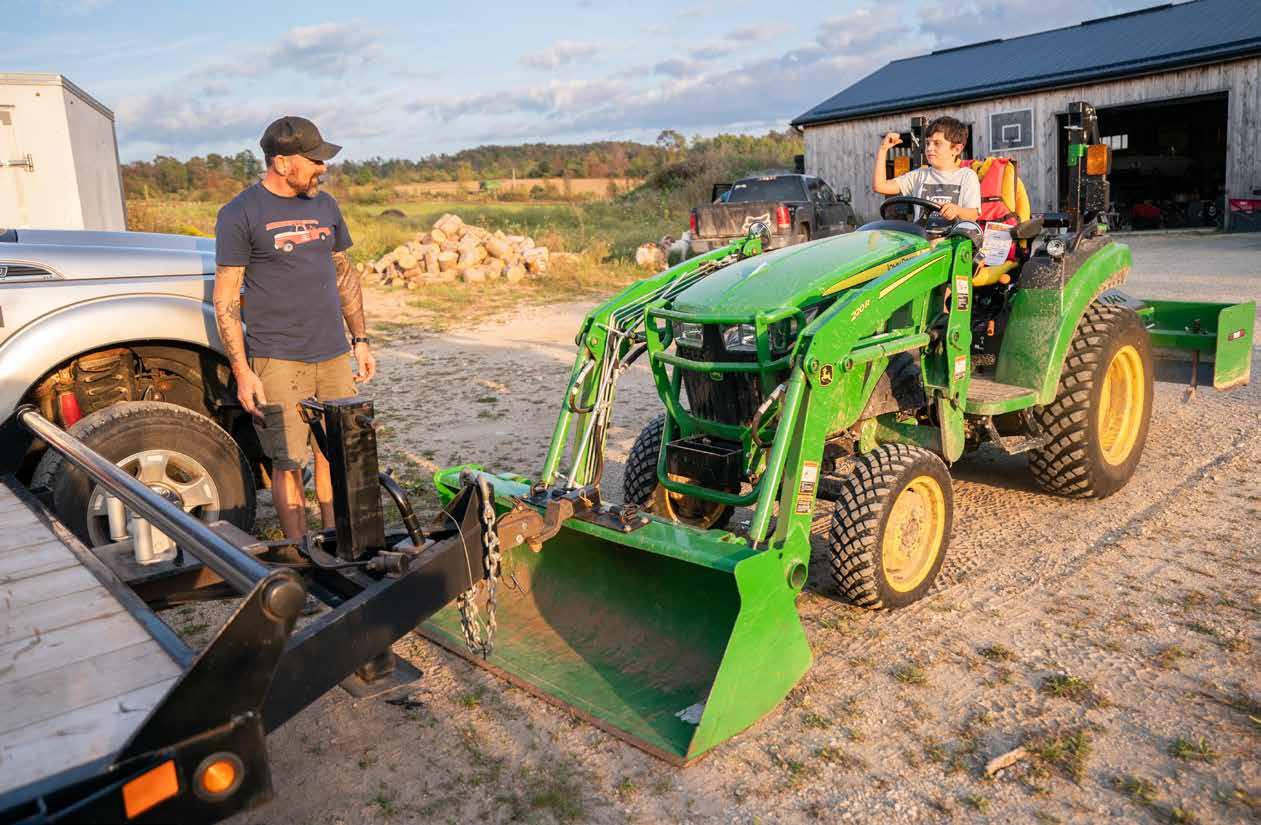

Bring luxury stonework and a gas fireplace into your living room.
Transform your living room with high-end stone work and a gas fireplace for one low price.
MBM Stoneworks is a high-end builder of luxury, premier stone installations, and has teamed up with One-Stop Home Comfort, installers of high-end HVAC systems.



Tyler (705) 816-4328
FIREPLACE STONEWORK:AND $11,980*
Hi I’m Mark, owner of MBM Stoneworks Masonry. I’m happy to announce that we have teamed up with One Stop Home Comfort to offer southern Georgian Bay homeowners the opportunity to bring the comfort and luxury of stone and fire into your living room now for a package offering at a very affordable price. I look forward to working with you.
Cheers, Mark (705) 333-4538


Life with the Honeywood-Burk family isn’t neat or quiet. It’s full of sawdust, bike parts, animals, kids, projects and noise. But inside all of it are the moments Adam says yes to—the camping trips, the apple cannons, the afternoons in the shop, the bikes leaning against the walls, the family dinners in the old farmhouse kitchen.
“I guess you could say it’s better than I imagined,” Adam says. “Still not on my radar. So yeah, every day I’m a little bit surprised by the cool shit I’ve got hanging around. Paid for. Family, friends, work I love. It’s all a bit of a surprise.”
For Adam, Bryn, Harper, Fiamma and Eddie, these are the good days—the noisy, messy, beautiful days they’ll look back on when the house is quiet.

OUR CLIENTS SAY, UNDERSTATED, BUT FULLY AND ABSOLUTELY STUNNING—IT’S IMPOSSIBLE TO NOT LOVE SCOTT YOUNG AND HIS TEAM.
It’s all about how your home feels.

We build your home with intense care and pride. We bring you all of our resources to construct your masterpiece—your home.


SCOT-BUILD DEV. INC. – (705 888 2759) scot-build.ca NORDIC / NORTHERN EUROPEAN & FULL CUSTOM HOME BUILDERS
Bring luxury stonework and a gas fireplace into your living room.
Transform your living room with high-end stone work and a gas fireplace for one low price.
MBM Stoneworks is a high-end builder of luxury, premier stone installations, and has teamed up with One-Stop Home Comfort, installers of high-end HVAC systems.


Mark (705) 333-4538

Hi I’m Tyler, owner of One Stop Home Comfort. I’m happy to announce that we have teamed up with MBM Stoneworks Masonry to offer southern Georgian Bay homeowners the opportunity to bring the comfort and luxury of stone and fire into your living room now for a package offering and a very affordable price. I look forward to working with you!
Cheers, Tyler (705) 816-4328








How a Ravenna couple built their dream retreat, balancing modern design, warm functionality and a deep connection to nature
words :: Kianna Sunshine photos :: Mitchell Hubble
Tucked deep into the forest outside Ravenna, Ridge House is the opposite of what most dream homes in the area promise. No sweeping Georgian Bay views. No chalet perched high on a hill. Instead, Krista and David envisioned something quieter: a modern retreat immersed in trees, where the morning soundtrack is birdsong and the neighbours are deer and foxes.
When they first walked the 25 acres of dense forest in Ravenna, they weren’t looking for a water view or a hilltop perch. What they wanted was privacy, trees and the chance to create a home that felt immersed in nature. “It’s like your own private retreat,” Krista explains. “We wanted to be tucked away, surrounded by forest.”
The land had once been partially cleared, with early signs of a build perched on a ridge. But when their architect arrived, she immediately saw a different vision. “She said, ‘No, the house belongs down here, set back into the woods,’” David recalls. “That shift made all the difference— it became the secluded oasis we’d imagined.”



Deer and foxes have wandered into the backyard, reminders that the forest is as much a part of the household as the walls themselves.
From the start, the couple gravitated toward Superkül’s work for its rare mix of clean-lined modernity and warmth. “A lot of modern homes can feel cold,” Krista says. “Theirs feel cozy, inviting, and still pristine.”
The result is a single-level home that flows easily, both visually and practically. Expansive nine-foot windows by Bigfoot frame the forest, while careful consideration of light ensures the interior always feels alive—morning sun filtering through one skylight, evening light pouring through another. As their architect explained, when you live in the woods, glass has to be designed thoughtfully: “At night the forest reflects back at you, so you want balance, not walls of glass.”
Inside, the details reveal the couple’s commitment to functionality as much as beauty. Custom millwork by Jeremy Van Severen of Coates Creek Cabinetry lines the kitchen, where towering cupboards replace the need for a walk-in pantry. “We’re tall, so we love the high storage,” Krista laughs. “I can spend $2,000 at Costco and it disappears into the drawers.” Every utensil, pot and pan has its place thanks to the millworker’s detailed planning.

The couple didn’t set out to build a huge space for entertaining. Instead, their home is intentionally designed for eight to ten people— kids, partners and close friends—gathering around the generous island or spilling out onto the screened porch. “It’s high-functioning without being excessive,” Krista notes. “We didn’t need two fridges and two stoves—we just wanted a kitchen that really works.”
Their favourite spaces reflect this balance of practicality and pleasure. Krista loves the serene bathroom, where a deep tub sits beneath soaring ceilings with views of the landscape. David is drawn to the screened porch, complete with a fireplace, where he can sit outdoors bug-free, even on summer evenings. In winter, the efficient wood-burning fire becomes the home’s cozy heart, fuelled by logs cut from their own property.


While the architect shaped the vision, it was the trades who gave Ridge House its lasting strength. Builder John W. Gordon came highly recommended and quickly earned their trust. “We wanted someone local, and John was fantastic,” David says. “The quality of his work was obvious.”
Jeremy at Coates Creek Cabinetry impressed them with exceptional craftsmanship, handling extensive millwork with precision. Landscaper Dave Van Ryn of Van Ryn Brothers Landscaping kept the setting natural, planting lowmaintenance gardens that thrive without daily care. “I never have to water it—it’s so well done,” Krista says. Huronia Blinds provided subtle, hidden blinds that vanish when not in use, while Bigfoot Windows framed the forest without distraction.
The couple describes the process as deeply collaborative, with Pinterest boards, questionnaires and even a written letter about themselves requested by the architects to better understand them. “They got to know how we live, then designed around that,” Krista explains. The result is a home where nothing feels accidental.
From the start, the couple gravitated toward Superkül’s work for its rare mix of clean-lined modernity and warmth.
Beyond the walls of Ridge House, Krista and David love the lifestyle their home anchors. David cycles the winding roads and trails weekly, while Krista enjoys the charm of Thornbury and Meaford’s independent shops and cafés. Together, they’ve built connections with local spots like Heart’s Restaurant, Good Grief Coffee, and Goldsmith’s Orchard Market. “We feel lucky to live somewhere with so many original places to eat and shop,” Krista says.
Closer to home, wildlife provides its own companionship. “The birds in the morning are phenomenal,” David says. Deer and foxes have wandered into the backyard, reminders that the forest is as much a part of the household as the walls themselves.






For all its considered design, Ridge House is not a showpiece—it’s meant to be lived in. Friends joke that the couple staged the home before they visit. “We laugh and say, ‘No, this is how we live,’” Krista says. The ample cupboards and clever storage make it easy to keep clutter tucked away, leaving the architecture and natural views to take centre stage.
The couple takes pride not just in the beauty of the house, but in how seamless it is to live there. “Everything flows—not only physically, but visually,” David explains. “You can stand in the middle and look out windows at both ends, with light shifting through the day. It’s intuitive, but it took a lot of thought.”
Though they designed Ridge House as a forever home, the couple admits they may not stay forever. Travel and new projects call to them. “We built from scratch, which was an amazing journey,” David reflects. “Now we’re asking: what’s next? Maybe a log cabin, maybe an old farmhouse that needs love. We just enjoy the process.”
Ridge House stands as a reflection of its owners’ vision: modern yet warm, private yet connected, deeply functional yet serenely beautiful. Every decision, from its placement in the woods to its indoor-outdoor flow, was made to honour the land and the lifestyle Krista and David wanted to create. Here in Ravenna’s forest, they’ve found a rare kind of luxury—not the grandeur of sweeping vistas, but the deep calm of living closely with nature. For Krista and David, that serenity is the truest measure of home.


Builder














words :: David Loopstra
For decades, Aspen, Colorado has been the poster child of mountaintown glitz—ski chalets with $40 million price tags, celebrities sipping pinot at altitude and high fashion floating through snowflakes. But underneath the glamour lies a very different story: one of municipal grit, policy innovation and a rare kind of civic backbone. This is the story of how Aspen carved out a space for the people who keep this mountain town alive—and became the affordable housing bastion inspiring other similar destinations, Blue Mountains included.
It’s one of those pre-storm winter days in the Elk range of the Rocky Mountains, where the town of Aspen, Colorado sits at 7,908 feet above sea level and night-time temps fall as low as -28C—definitely making indoor sleeping arrangements a must-have—and two very different conversations about accommodation in Aspen are occurring simultaneously.
First, up top of Aspen Mountain, Lucretia, 53, a realtor from Miami originally from Colombia, and her friend Ana are posing for a Mountain Life photographer.
(“We saw them, and we needed their photo,” the photographer mused later.)
“We are staying at the St. Regis,” explains Lucretia, name-dropping one of Aspen’s many lux hotels where mid-winter rates top $2500 USD per night. “And we are looking at real estate. We come for two weeks every winter—sometimes two weeks every summer, too. Summers here are just beautiful. So we just want our own place, you know?”
Meanwhile down at the airport, Tyler, a shuttle driver for Aspen Meadows Resort, tosses this writer’s ski bags into the back of the shuttle, accepts a $20 tip, and prepares to dispense some key information—both about how he affords to live in this paradise, and also where the best stashes of powder are. Tyler explains that his apartment—a one-bedroom unit in a complex called Truscott Place, perched on the edge of the Roaring Fork River—costs him $1,200 a month. In Aspen.
Asked how that’s possible, he laughs a bit and says,”long story.” (But for powder? That’s an easier answer. “Anywhere man, on a powder day, but Split Tree Glades at Snowmass hold secret stashes and Buttermilk is always overlooked because it’s more for families, so you can get fresh tracks midday right under the lifts.”)
“OK, tell us how this affordable housing thing works,” another traveller from Canada in the shuttle asks, equally curious.
“It’s not luxury,” Tyler says, turning down one of Aspen’s perfectly designed boulevards. “But it’s safe. It’s clean. It’s close. And I can actually live where I work.”
That simple truth—living where you work—is now a rarity in many ski towns. But in Aspen, it’s the result of more than four decades of careful, often contentious, housing policy. And for many who follow the intertwined issues of gentrification, sustainability and rural labour, Aspen has become something of a case study: a rare place where the town didn’t just survive its housing crisis, but flourished because of it.
By the Numbers
Total number of mountains: 4
Total skiable terrain: 5,500 acres
Average snowfall: 307 inches
Average winter temperature -8C
Base Elevation: 7,945 ft./2,422 m
Summit Elevation: 11,212 ft./3,418 m
Vertical Rise: 3,267 ft./996 m
Terrain: 675 acres/273 hectares
Number of trails: 76
Miles/km of trails: 64 miles/103 km
Longest run: 3 miles/4.8 km
Lifts: 8, including 1 six-passenger gondola
Base Elevation: 8,104 ft./2,473 m
Summit Elevation: 12,510 ft./3,813 m
Vertical Rise: 4,406 ft./1,343 m
Terrain: 3,339 acres/1,351 hectares
Number of trails: 98
Miles/km of trails: 147 miles/237 km
Longest run: 5.3 miles/8.5 km
Lifts: 3 (including an 8-passenger gondola)
Base Elevation: 8,040 ft./2,451 m
Summit Elevation: 11,675 ft./3,559 m
(top of Highland Bowl 12,392 ft/3777 m)
Vertical Rise: 3,635 ft./1,108 m
Terrain: 1,040 acres/421 hectares
Number of trails: 144
Miles/km of trails: 84 miles/135 km
Longest run: 3.5 miles/5.6 km
Lifts: 5
Base Elevation: 7,870 ft./2,399 m
Summit Elevation: 9,900 ft./3,018 m
Vertical Rise: 2,030 ft./619 m
Terrain: 470 acres/190 hectares
Number of trails: 44
Miles/km of trails: 21 miles/34 km
Longest run: 3 miles/4.8 km
Lifts: 8 (3 high-speed quads, 1 double, 4 ski/snowboard school lifts)
• Aspen Meadows Resort by the Salamander Collection
• Limelight Hotel
The seeds of Aspen’s affordable housing program were sown in the 1970s. By then, the town’s growing popularity had already sent real estate prices soaring. Ski instructors, bartenders and teachers— people who built the culture and economy of Aspen—were being priced out. Many were commuting from as far away as Glenwood Springs, over 40 miles down-valley.
“Back then? Aspen was a ghost town at night,” says Bob Duncan, a real estate investor from Fresno, California, who dispensed some key insider information on the gondola up Snowmass one powder day. “The people who made the town function couldn’t afford to live here anymore. So locals had to live down the highway.”
Duncan is a true Aspen aficionado. He’s 64, and a die-hard fan. He’s bought and sold real estate in Aspen for the last 20 years. “Let’s just say that that [real estate investing in Aspen] has helped me reach my current goal. I’m retired, man. I don’t need to own. I just rent hotel rooms now.
“It’s about community. They’re not just building homes—we’re preserving a functioning town.”
“Could I get cheaper accommodation up in Idaho, or Montana? Yes, but really? Is it Aspen? Aspen is unmatched in the USA. The best restaurants, ski town vibe, and man, the skiing here is incredible. I mean, four mountains? There’s a reason they call it Buttermilk, man. It’s creamy. And skiing through aspen trees is just unreal.”
In 1974, the city passed its first ordinance requiring developers to contribute to affordable housing stock. A few years later, it created the Aspen/Pitkin County Housing Authority (APCHA)—a public-private partnership tasked with overseeing what would eventually become one of the most comprehensive affordable housing programs in the country.
Today, APCHA owns and manages over 3,000 units of deedrestricted housing. Roughly 60 per cent of the city’s workforce lives in affordable units. The model is complex—but effective. Here’s how it works.
At the heart of Aspen’s system is a simple principle: locals first. To qualify for a unit, applicants must work at least 1,500 hours per year within Pitkin County. Homes are categorized into income


That simple truth— living where you work—is now a rarity in many ski towns.
and asset brackets, with prices capped accordingly. For example, a one-bedroom condo in Category 3 (mid-level income) might sell for $210,000—about one-tenth the cost of a similar unit on the open market. The kicker? Owners can only resell the unit at a modest, regulated appreciation rate, typically around 3 per cent year.
“For APCHA, it isn’t about profit. It’s about community,” says Duncan. “They’re not just building homes—we’re preserving a functioning town.”
That town includes janitors and nurses, but also city planners, artists and entrepreneurs, who can all take advantage of free transportation courtesy of the Roaring Fork Transit Authority.
“The idea that a ski town can be a full-time community and a sustainable one—that’s what Aspen is preserving,” adds Duncan.
Of course, Aspen’s housing model is not without flaws.
For one, supply still doesn’t meet demand. The waitlist for some units is years long. APCHA has struggled with enforcement issues— some owners have illegally rented out units on Airbnb, or moved away while still claiming residency.
And then there’s the fairness debate. “Why should someone get a million-dollar view at a fraction of the cost just because they work at the ski hill?” one local business owner asked, requesting anonymity. “What about people who’ve been here a long time but technically don’t ‘work’ 1,500 hours a year? Retirees? Artists?”
Duncan acknowledges the tension. “It’s a balancing act. But without these controls, the market would eat this place alive. I mean
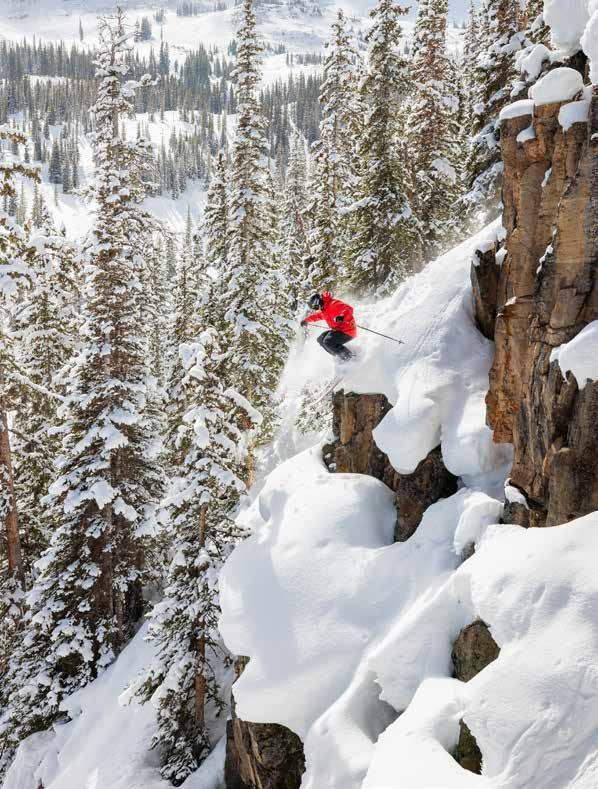
look at you. You’re here, right? All of those [affordability measures] mean this place is accessible.” He smirks and continues, “even for Canadians with your dollar.”
In Aspen, the focus is on sustainability. The message on the billboard welcoming visitors at the airport says it all: Aspen. Defy Ordinary. The campaign was designed by the Aspen Chamber Resort Association (ACRA), a hybrid of a chamber of commerce and a destination marketing organization. The messages then go on to feature Aspen locals reciting the Aspen Pledge: “I will find adventure, but not venture off marked trails,” says one.
“I will remain in one piece by leaving the wildlife in peace,” says another. They are aimed at sustainability in all senses, and affordability is a key part of that—also, surprisingly when it comes to climate change. Affordable housing near town doesn’t just strengthen the community—it reduces traffic and emissions. Commuters from the lower valley spend hours on the road each day, contributing to greenhouse gases and clogging Aspen’s narrow roads.
In fact, the Aspen Skiing Company, which owns the resort, has worked hand-in-hand with city officials to incorporate energyefficient design into new workforce housing, installing solar panels and air-source heat pumps in newer housing complexes.
Aspen has been recognized for its dedication to sustainable tourism. In 2024, the city earned the Mountain IDEAL certification, acknowledging its commitment to environmental stewardship and sustainable destination management. Furthermore, ACRA’s efforts led to Aspen being featured in the 2023 Green Destinations Top 100 Stories, a global list recognizing innovative sustainable tourism practices.
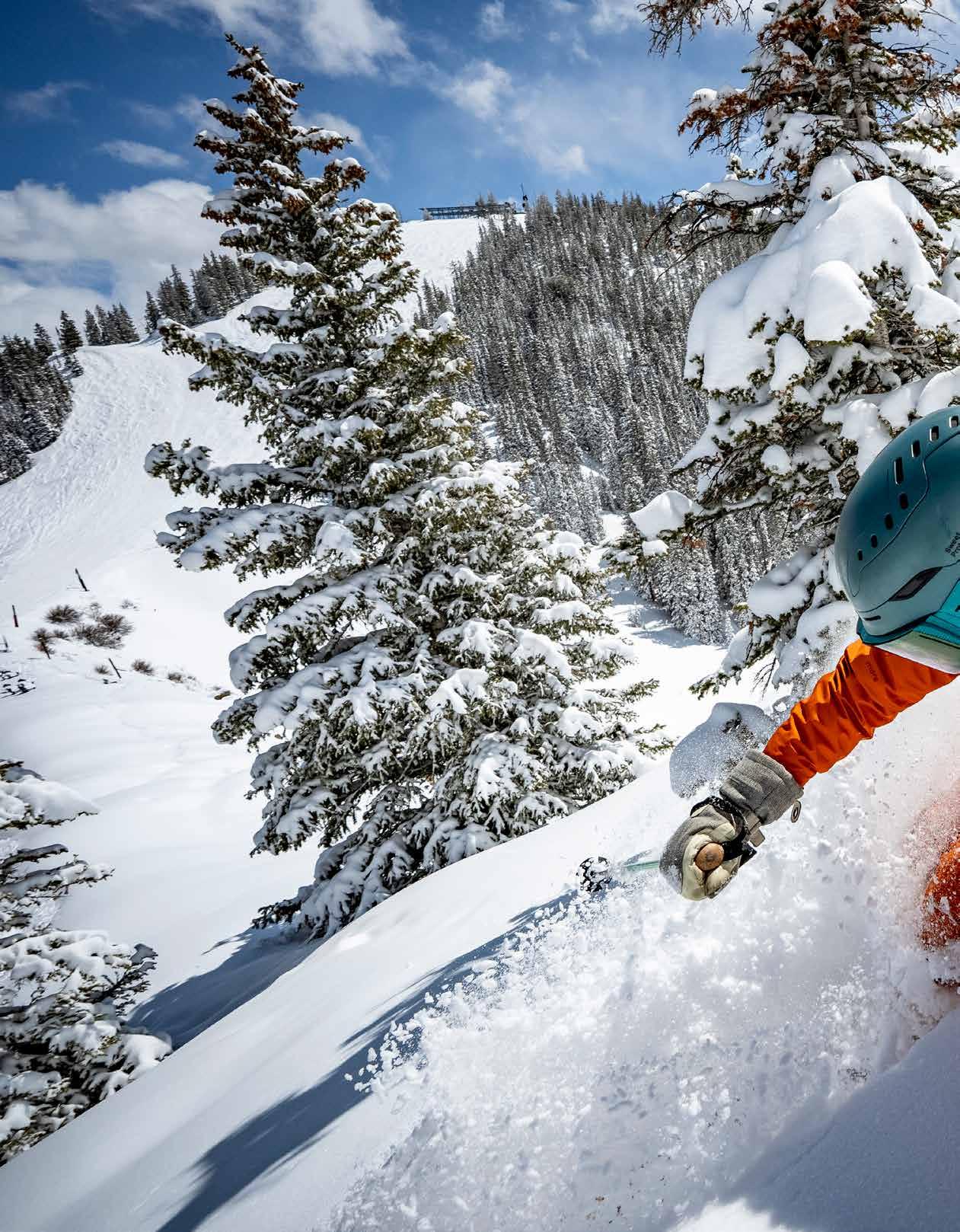


Aspen’s model isn’t perfect. But it’s working. And it means that, for tourists like the Mountain Life crew from Canada, Aspen is easy to navigate. It’s clean, fun, accessible and staffed with friendly, knowledgeable locals. And for a ski resort boasting an average of 66 snowfall days per year, that’s about as good as it gets.
Other resort towns, including our own Blue Mountains, are watching closely. Some have already adopted elements of the APCHA playbook: deed restrictions, employee housing requirements and caps on short-term rentals.
Back on the shuttle to Aspen Meadows, Tyler smiles and says there’s more snow in the forecast.
“It’s coming tomorrow, man,” he says. “Wait ‘til you experience an Aspen powder day.” When he’s done driving the shuttle, Tyler is headed to his evening work as a server at a local high-end restaurant. But he’s living his best life. He doesn’t start work until 2 p.m. tomorrow, so he’s getting a satisfying mountain day first.
“Tomorrow is going to be sick, man,” he says. “I hope you are stoked.”
(And by the way, it was: snow like buttermilk, creamy, not crowded—perfect.)
And up at the peak of the mountain, Lucretia and Ana ski off. They’re on their way back to the St. Regis and then to RAKxa spa, which lives up to its name for some high-end treatments.
That’s the real mountain dream. For everyone. And in Aspen, against all odds, they’re keeping it alive—defying ordinary.
Got feedback, tips, or your own ski-town housing story? Send us a letter! mlbm@mountainlifemedia.ca
There are plenty of similarities in the challenges that southern Georgian Bay faces as a mountain adventure playground. For years, civic officials have wrestled with the concept of ensuring there’s accessible and affordable housing for everyone. Here in The Blue Mountains, after a 2023 Housing Needs Assessment revealed deep gaps, the town drew on community input from the BMRA Housing Strategy Working Group to shape a new Affordable Housing Action Plan The goal? Ensure 30 per cent of new homes meet affordability targets.
The plan leans on both policy and creativity: an overhaul of the Official Plan, a smarter waterallocation bylaw that prioritizes affordable projects and a refreshed Community Improvement Plan with fee waivers and incentives. Town staff are also pushing for inclusionary zoning, developer roundtables and partnerships with nonprofits like Habitat for Humanity. With a projected expenditure of $478,000 over two years—most of it already budgeted—the strategy aims to make workforce housing as integral to the Blue Mountains’ future as lift tickets and trail maps.

Dave Loopstra is a skier, mountain biker and currently the publisher of Mountain Life Blue Mountains. He loooves skiing deep snow.






























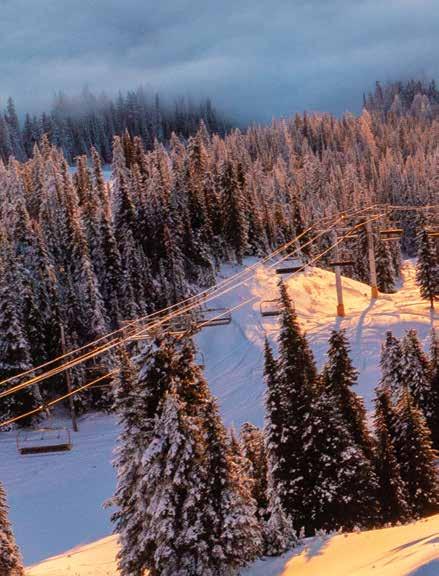



















































































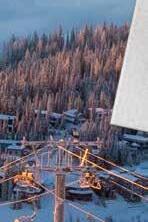







































Riding solo on a high-speed six-pack, I scan the treeless mountain ahead. I’ve been camped out at Club Med Serre Chevalier for a week, but have been too busy eating, skiing and eating even more to take a single photo. Today is my last chance. The gleaming background of blinding snow and sheer rock faces is ripe for the picking; I just need a skier. Turning my gaze back to the left, a dervish of red and blue catches my eye. The swirl of colour launches from high on the ridge, somersaults in slow motion and sticks a landing in the soft spring snow.
I think I found my guy.

Chasing him down (only possible because he’s at a dead stop), I discover Paul de Pourtalès is happy to be my model. And I’m over the moon to have found him. He’s patient and kind, happily pausing to wait out the passing clouds. He asks for direction, delivers perfect turns. Climbs back up, again and again. The guy is such a pro.
Wait, it turns out he actually is a professional skier, a newly minted member of the Freeride World Tour. I’ve stumbled upon one of the best freeriders on the planet. And honestly, the charmed experience seems the norm for this place.
Tucked into the far southeastern corner of France, less than an hour from the Italian border, Serre Chevalier is the largest ski area in the southern Alps and one of the best spots in the entire range for spring skiing. It’s the last week of March, and every day my friend Theresa and I find late-winter conditions on the top half of the mountain and spring conditions at the bottom. It’s sunny every day, the snow is like butter—and the entire experience is all tied up in a neat little Club Med bow.
Once known for its beach-bound resorts and singles vibe, Club Med began reimagining itself around the turn of this century as a family-friendly brand, appealing to an upper tier of travellers. While the chain still has a foothold in warmer climes, it also boasts 17 all-inclusive hotels in the Alps (and one in Charlevoix, QC). Our iteration here in the tiny village of La Salle-les-Alpes has just emerged from an extensive remodel, reopening a few months ago with a bright, traditionally inspired motif.

Because it’s late season, things are winding down at the hotel, where the high-season capacity of more than 900 guests is only half realized and the front-ofhouse staff chatters away about packing for their next assignments. Amélie, who helps with public relations, has been with Club Med for two years, at four resorts in three countries. Sally, who’s worked her way up the ladder at the sprawling daycare, has worked at nine resorts in six years.
We know their history because, at nearly every meal, someone offers to sit with us and chat. They love their jobs, they adore Club Med—but they’re also honest about their demanding work days, which begin before breakfast and end long after the evening entertainment peters out.
The front-facing staff—they’re called G.O.s, while cooks and housekeepers are G.E.s; as guests, we’re G.M.s (long story, just go with it)—are your point of contact throughout the day, welcoming diners in long, exuberant receiving lines at meals; staffing the desks at the reception, spa, bars, boutique and aforementioned childcare; performing at the evening stage shows; leading the Club Med Crazy Signs dances (no explanation, just play along) that spontaneously erupt during mid-day patio and at late-night dance-floor parties.
The only thing the G.O.s don’t do, it seems (besides sleep), is guide outdoor activities. Local pros take the lead for ski school, snowshoeing, Nordic skiing, sledding (the list is long, and much of it is included in the price of admission). Theresa joins a week-long ski lesson, which commences with a round of schnapps and leaves her not only a far better skier by the trip’s end but with connections to a multinational group of fellow skiers.







It’s sunny every day, the snow is like butter—and the entire experience is all tied up in a neat little Club Med bow.

Activities aside, our days are primarily structured around food. An overabundance of food. Overwhelming selections of food. Stations stacked with choices span the dining room, each stop with its own rotating theme and much of it prepared to order. It’s a very “Poof! What do you need?” Genie-esque experience, and we’re at first taken aback but eventually acquiesce. Breakfast, lunch, après, dinner. Plate after plate, bowl after bowl. It’s miraculous we don’t outgrow our pants by the second day.
We take a seat for a few after-dinner stage performances, including a full-costume hyper-speed lip sync of Beauty and the Beast and an adorable end-ofweek production from the children. But most nights we head out for a much-needed after-dinner walk, roaming through the narrow, winding lanes of the old village.
A day visit to the ancient walled city of Briançon requires a quick bus ride, and we tick that box later in the week, feeling a bit guilty leaving the Club Med world behind but also refreshingly free, exploring on our own and making a day of it with a long, sunny mountain hike beneath paragliders shouting, “C'est magnifique!”
One afternoon we click in for a guided snowshoe adventure, rattling up the ‘60s-era two-person gondola to traipse through the woods above another village. Someone in our group makes a plea for special treatment while another woman fires off a difficult scheduling request. Our obliging guide flashes a wide grin and says, “Yes, of course!” and reminds us, “Everything is possible at Club Med.”


Why settle for bulky synthetics when you can carry the power of down? Puff neck gaiters are made of ethically-sourced duck down insulation and a waterproof shell, so you’ll be stylish and warm all winter long. Don’t just face the cold, embrace it.

designs pu .design









words :: Leslie Anthony
An old Latin phrase, solvitur ambulando—“it is solved by walking”—owes itself to a mic-drop moment by the ancient Greek philosopher, Diogenes, who found himself debating someone who believed motion to be illusory and impossible to prove if the moments you examined it in were small enough. After listening to his opponent’s reasoning, Diogenes simply got up and walked away—a demonstration that mooted the pointless paradox.
In the millennia since, the expression has been co-opted by everyone from Darwin to the Dalai Lama as a stand-in for the idea that movement aids cognition. Need to sort through a problem or clear your head? Go for a walk—or a run.
I’ve keened to this adage my entire writing career, craving both motion and leitmotif of forest or field after long days on the laptop. I’ve experienced revelations while running that echo others’ descriptions of ideas coming to them in dreams—figuring out the way into a flummoxing story, or a lightbulb
going off on the elusive ending to a book. I’m out there for the head health, but the cardiovascular benefits are a welcome bonus. As it turns out, everyone who runs has their own reasons; what we all share, however, is that more and more of us are doing it.
Though running’s popularity has ebbed and flowed over the decades, its overall trajectory has been up, the most significant inflections tracking events or new technology. In recent years, the pandemic brought many to running as gym-free fitness and a cure for boredom at the same time advances in high-performance footwear were enhancing the experience. Related tech like GPS watches and fitness apps have been turbocharged by social media lifestyle platforms, with #running accumulating over 100 million posts on Instagram and half a billion on TikTok. And rail-to-trail conversions and rabid backcountry trail-building have increased running’s available real estate. With more people than ever taking it up, running is clearly part of the zeitgeist. One undeniable metric is the number of run clubs popping up.
“There’s a group for any interest and ability,” says Caitlin Foisy, founder of Collingwood Runners. “Many start with people who see a need—like ‘I can only run on Monday evenings’ kind of thing. So they start a club and put it out on social media. I have friends who’ve started ‘dry’ run clubs [no post-run beer] and groups for people of colour or socio-economic status—safe spaces for those excluded from other areas.”
Unlike many runners (a recent UK survey found most take it up in their 30s and 40s), Foisy’s life has been all things running from the get-go. She remembers her father training for the Boston Marathon and has photos of herself running a 1k as a 5-yearold. No surprise she ran throughout high school and made both Cross Country and Track & Field teams at Queen’s University. “That’s where I realized you actually have to train to do well,” she recalls. “Later I moved west for work as a bike-tour guide but always did trail races to explore where I was living in a way you can’t from a car or bike.”
For Foisy, running is both stress relief and a way to burn energy. “It’s a great way
to test yourself or just go really casual,” she says. “There are so many ways to switch things up, it’s hard to get bored.”
Collingwood Runners looks to create more running and racing opportunities locally so people don’t have to travel so

morphed into a running store due to both demand and opportunity. “Initially we had a bit of cycling but Covid messed up supply and the bike industry is so up-and-down we decided to focus on running,” adds Bechtel.
Naturally, they started a run club. And
Everyone who runs has their own reasons; what we all share, however, is that more and more of us are doing it.
far, whether beginners, those looking for elevated coaching experiences, or just community. “A lot of my friends are moms, and the only time we see each other outside family stuff is running,” says Foisy, now juggling life with three kids. “I’m grateful the sport has brought these people into my life.”
This aspect of connection is voiced by many runners. “Almost all the friends I have here I’ve met through run club,” says Mark Bechtel, who, with brother Sean, owns VO2 Sports, Collingwood’s running ground-zero. Launched as a multi-sport shop in 2019, VO2
again, Covid had other ideas. Resurrected after lockdown as a more casual meet-andrun than structured workout, the club took off among young folk, drawing 50–60 on a Wednesday night. “Clubs are a big social thing,” notes Bechtel of how type-B fun can still ignite a passion. “But once you get past the hump of going for a run and not thinking you’re going to die every time, there’s not much money to invest, either.”
Eventually, the club spawned a popular race—the Collingwood 10K. “The organizer of a previous race left town so there was
a hole and we dove in,” says Bechtel. Each installment has sold out: 300 in 2023, 500 in 2024, on pace for 600 this October.
There’s also a kids’ fun run that sees participants receive a t-shirt and medal.
“This year we brought in a local sponsor to offset costs and keep it free,” says Bechtel.
If clubs are the corpus of the running community, races like the Collingwood 10K are its lifeblood. With 40 per cent of participants from out of town, such events also demonstrate how, befitting their mien, runners also like to travel. Enthusing on her favourite races, for instance, Foisy not only waxes local, but drops the Rev & Run, a 5K held on the closed Honda Indy racetrack in Toronto only hours after drivers have vacated. “It’s one of Canada’s most unique races,” she says. “Amazing vibes and also a fundraiser for the Parkdale food bank.”
Running in general may be staging a moment, but its hayseed cousin, trail running, has mounted a breakout performance. A perennial favourite is the Falling Water Trail Marathon/Half-Marathon, held on the Beaver Valley section of the

Bruce Trail and featuring waterfalls, steep climbs, scenic views and abundant post-hoc “harder than expected” commentary. It was the first event that Kimberley resident Jayar La Fontaine found his way to when his daily 5k walks morphed into 10k maintenance runs after listening to an audiobook of Haruki Murakami’s memoir, What I Talk About When I Talk About Running. “It was inspiration to actually run the route. And then suddenly I was going out more often and for longer,” recalls La Fontaine.
With last year’s marathon falling on his birthday, a friend nudged him into training for it. He’d never raced, didn’t have a coach, but stuck diligently to the schedule, diet regimen and getting the right gear—waypoints of the all-consuming obsession running can become. Which happened fast for La Fontaine. “After Falling Water, I was in shape so I did five more trail races—short ultras of 50–58k—
chaining them together with a two-week gap between each. I wasn’t entering to win but it was fun to compete with top finishers, who are clearly a different species of human, and see where you’re at compared to what they’re capable of.”
Putting yourself out there all starts with your first race. Also within striking distance are two popular late-October races on the Maitland Trail—The Bad Thing, with point-to-point 25k and 50k options, and The Night Thing, where headlamp-adorned runners experience how coyotes and raccoons see the world. The biggest of the bunch, however, is the Summit 700 at Blue Mountain Resort.
“Every race is a microcosm of life, and each teaches me something new about myself.” – Jayar La Fontaine
The race grew out of The North Face Endurance Challenge that first came to the resort just over a decade ago, fueling local interest in the sport. “It was like a big-city marathon in trail-run format,” recalls Bob Miller. When The North Face series ended in 2017, Miller had been the local contact, sorting volunteers and working on courses. Conversations with counterparts in the Blue Mountain Resort events department led him to inaugurate the Summit 700 in 2018, since held annually in July on the resort’s extensive singletrack network. The number 700 refers to the climb in feet up the Niagara Escarpment that each 5k, 10k and 21k course delivers—in addition to a trailrunner’s usual catnip of rocks, roots, creeks and forest. “We try our best to provide the same experience as the North Face event but without the same budget. Still, there’s a great post-race atmosphere in the Village at the finish,” says Miller.
Now approaching 1,000 entrants, in addition to the traditional distances run on loops, 2025 also saw a new point-to-point 50k. “When we started, 80 per cent of participants did the shorter distances, but that changed over time and this year’s 50k was a real highlight, with over 100 runners bussed to a remote starting line,” he says. “As an athlete, my favourite missions were always those that made me feel I was going somewhere.”
While a great experience for runners, the behind-the-scenes vibe of a big event can be trying for organizers. On a top-10 list of the most-stressful jobs—a litany that includes wildfire fighters—you’ll also find event director. “It’s like putting together all the pieces for a multi-day adventure tour but for just a single day,” says Miller.
I N S







w w w . v o 2 s p o r t s c o . c o m | 1 2 4 H u r o n t a r i o s t , c o l l i n g w o o d


And there’s more: Alicia Tone founded Collingwood’s Run For Her, a fundraiser for ovarian cancer. Beginning as a solo halfmarathon in 2020, for which she elicited $1,800 in support, Tone has quickly grown Run for Her to a multi-distance trail-race, education and advocacy initiative, collaborating with local businesses and the patient community. All $70,000 raised to date has gone directly to Ovarian Cancer Canada.
Not only are more boutique and focused run events seeing growth, but also splinter sports like “canicross”—cross-country running with dogs where runners utilize hands-free equipment that allows the dog to run in front and pull them along while they give commands. Mono resident Shawn Sobon is behind Canadian Canicross Sports, which holds racing events including the Trails & Tails Classic, Muddy Paw and Snowy Paws.
In the end, the running world all devolves back to community. No matter the type of event, unifying themes include how mid- and back-of-the-packers are celebrated with the same enthusiasm as frontrunners, and tacit acknowledgement that running can be an integral part of someone’s journey through personal challenge. At
races, cheerers-on are often spotted holding signs saying things like Therapy Was Also an Option
“Every race is a microcosm of life, and each teaches me something new about myself,” says La Fontaine. “Distance runners say when you’re feeling awful—like nothing’s working, your body feels like it’s going to fall apart, and you’re in a negative mental place—just wait a few kilometres and everything might turn around. I’ve experienced that, too.”
You know, solvitur ambulando

Leslie Anthony is a writer, editor, biologist, bon vivant and author of several books who is happiest skiing pow, paddling a canoe and searching for snakes. He’s never met a mountain he didn’t like.
















words :: Nadia Pestrak
An innovative businessman, musician and outdoorsman, Paul Woolner possesses a deep curiosity that draws him into experiences most overlook. While this region is known for skiing, few know where to find Beaver Valley’s backcountry powder. And while plenty play in Georgian Bay and Lake Huron, not many know the Bay’s waves well enough to surf them. Like his song by the band he plays in, Live the Dash, Woolner believes in “Let[ting] the Dreams Come.” “It’s one thing to have dreams,” he says. “It’s another to act on them.”
Woolner’s biggest passion is learning. His twenties revealed his versatility as a student: After dropping out of university, he lived off the grid on a farm in PEI, working as a music director for a puppet theatre and performing in a band while gardening and beekeeping. He spent many nights playing music with others in the community. He says his experiences in intentional communities—bands, communes—made him want to study learning and change in individuals, groups and organizations, so he went on to complete a BA in Applied Social Sciences and then a Masters and Doctorate in Education at the University of Toronto.
Woolner’s career in organizational strategy and leadership has included advisory, partner and co-founder roles in many entrepreneurial businesses. “What I’m really passionate about is building companies where I’d feel good about my own kids and other people’s children working,” he says, referring to both the employee development and the impact of the business on the wider community.
That same sense of purpose and connection extends beyond work, into Woolner’s deep engagement with outdoor sports and music. His home in Beaver Valley backs onto protected forest. Woolner advocates and fundraises for the Escarpment Corridor Alliance’s mission to preserve escarpment lands. “This area is truly a public resource,” he says, “and should be retained for that purpose.”
Case in point: from his back door, Woolner and his wife can step into skis and start climbing the escarpment. “You can hear the gales roaring over the top of the cliffs,” he says. “It sounds like you’re next to a waterfall or the edge of the ocean or Lake Huron when it’s really going off.” Below the cliffs, the air is still. “There’s a beautiful,
protected forest full of powder snow. In 20 years, we’ve only seen other people three times.”
A sense of discovery also drives Woolner’s connection to water. Woolner has long chased waves—through 35 years of windsurfing, longboarding in Maui and northern California, and, most recently, SUP-surfing on the Great Lakes. “About 20 years ago SUP surfing came along, and I remember thinking, Is this just a gimmick?” After
“We’re surrounded by energy—waveform energy— sound waves, light waves. Surfing is playing with energy at a human scale.”
demoing a board at a surf shop in Sauble Beach, he was sold. “I knew right away this would unlock surfing in the Great Lakes. With SUP surfing, you’ve got the blade of the paddle and the leverage the long handle gives you, so you can catch waves earlier and ride longer.”
Much like backcountry skiing, though, surfing Georgian Bay and the Great Lakes demands a deep understanding of the environment. “The right waves are like rare orchids. They’re only there once in a while,” he says. “The same spot is never the same spot, so you really have to become a kind of meteorologist or wave scientist to figure out where to be, when.”
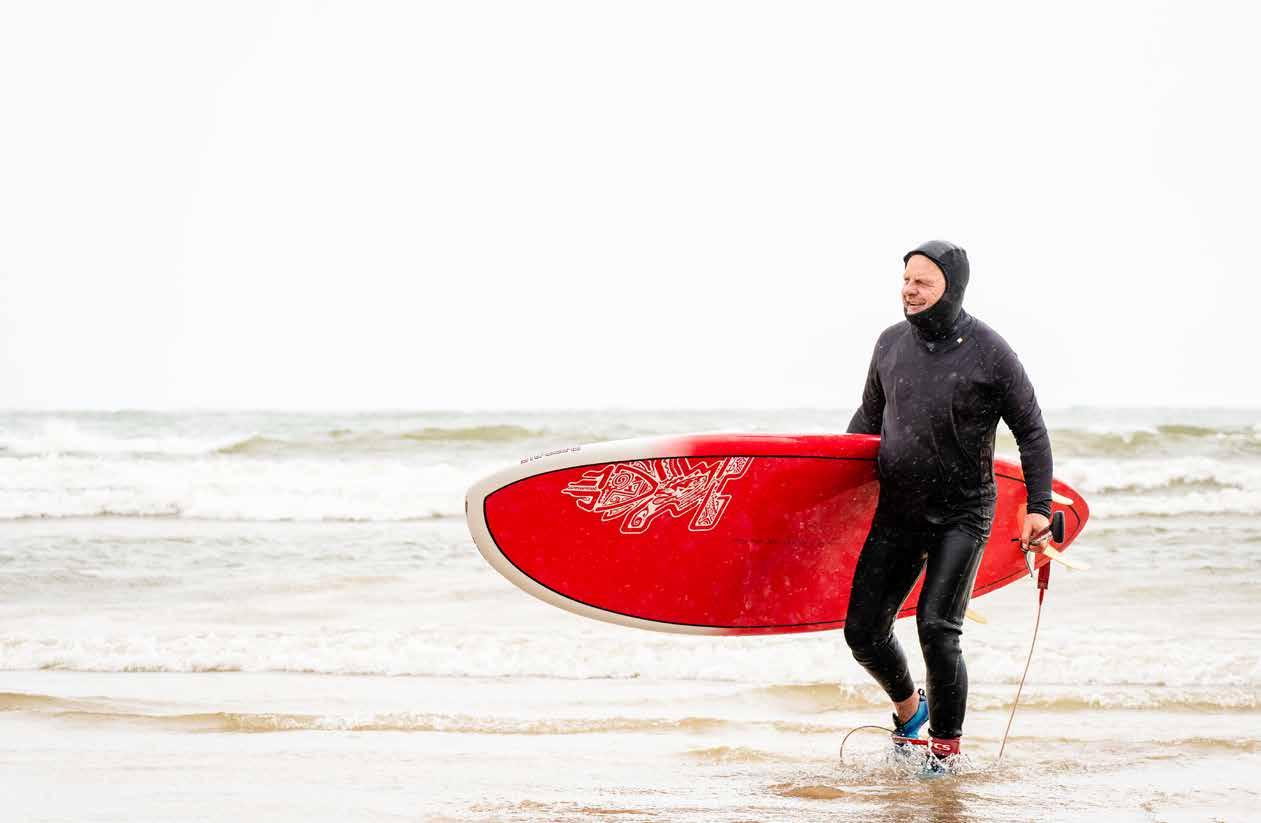
“You’ll get winds that blow at, say, 20 knots for hours, and then the wind will stop. But the waves keep coming because they’ve got hundreds of kilometres to journey. And as the waves go through the water, they literally start to harmonize. So instead of six waves, they become three, the distance between them lengthens, and the energy becomes additive. They go from being chaotic to more predictable and break in a way that makes them much more rideable.”

For Woolner, it’s a mindful practice. “We’re surrounded by energy— waveform energy—sound waves, light waves. Surfing is playing with energy at a human scale.”
That same sensitivity to flow and energy carries into his music. Woolner began playing trumpet at age nine, then picked up guitar and soon started writing songs and toured Canada as a teen, and now, decades later, has a new album, a solo project—Memory Like Water—recorded largely at home in Beaver Valley with producer Thomas Mackay and set to be released by Sony Music’s The Orchard. “It’s also the first time I’ve worked with a really creative producer. Most of it we recorded right here in this home. Tom would come up from the city and we’d spend days at a time just working on it.”
Woolner plays locally solo and with the bands at the Rockin’ The
River Festival, Heartwood Hall, Marsh Street Centre and occasionally drops in to open mics at the Corner Café. But the deeper music culture, he says, is often hidden. “A friend in the valley puts on a music festival with over a hundred people every summer. If you’re not a friend or a friend of a friend, you wouldn’t know about it.” Another friend hosts solstice celebrations in her barn. Still another has parties packed with musicians clustered around her kitchen table.
What happens in those moments is special. “There’s a term called entrainment,” Woolner explains, referring to brainwave frequencies that fall in step. “There’s a magic when you are listening, and you all start to come together in service of the song.” He’s talking about jamming—but he could just as easily be describing appreciation for the hidden wonders of the valley itself.

Nadia Pestrak is a writer who recently traded rural Duncan for small-town Clarksburg, chasing a '70s-style childhood for her kids— complete with bikes, slushies and cannonballs off the pier.


































Sean Rennie, Community Leader & Mountain Lifer
words :: David Loopstra
If you’ve run a kid through Collingwood’s Mountainview Elementary School, there’s a good chance your kid has—as a creative writing assignment—taken home Bob the Bass, a beat-up, taxidermied “pet” fish from the classroom of teacher, local legend and communitybuilder Sean Rennie.
“You need to get kids excited about writing, and Bob leads to tons of funny stories,” Rennie explains one October afternoon over après. Then he laughs. Bob has found his way to Thanksgiving dinners, family reunions, sleepovers, cottages—Rennie has a file folder full of Bob’s adventures.
It’s part of Rennie’s leadership style, and a glimpse into what inspires him.
There is always a giant laugh about to spring from Rennie’s lit-up face; it’s impossible to picture this guy in a bad mood. Rennie epitomizes living the Collingwood mountain life to its fullest. He’s a skier, mountain biker, the recent recipient of the Order of Collingwood (2023) and has volunteered countless hours—for the Optimist Club, as a rugby coach, and for the Georgian Triangle Anglers Association.
To sit with Rennie as he runs through his favourite stories is like sifting through a photo album. There’s the time he went ski training in Chile with the Southern Ontario Division Ski Team, when Pinochet was in power, skiing past bullet-hole-riddled Cessnas and exchanging cash on the black market just out of view of machine-gun-toting soldiers.
Rennie grew up at the base of Blue Mountain, “On Carmichael Crescent,” he says. “Back when, if you were poor, that’s where you lived.” ML caught up with Rennie this past fall to ask him his secret to being an effective and inspiring leader and how to live your best mountain life.




ML: Why do you love being a youth leader?
SR: It allows me to give back to the community in a positive way. It feels great to be able to give youth organizations money that we have raised through our local events so they can run programs and buy resources for youth in our community. In coaching, I really like seeing kids push their limits and get outside of their comfort zone. There is nothing better than seeing a kid learn something new and gain confidence in themselves.
ML: You always seem so happy. How?
SR: I am a true optimist at heart and always look for the positives in everything I do. I also try to spend as much time as possible in the woods, mountain biking, skiing and hiking, and this gives me a lot of positive energy. Another thing that keeps me happy is spending time with my family and friends.
ML: Why is it important to get kids outside?
SR: It’s so important for their physical well-being and motor development, [providing] opportunities for kids to explore, create games or build things with items they find. It encourages kids to use their imagination and also exposes them to what nature has to offer—insects, animals, birds, trees and plants. As a teacher, I have found that it improves their overall mood and helps them focus more on their work when they return to class. Kids need to be active, and there is no better way to do that than taking them outdoors.
ML: Fav place to bike in November—and best November beer?
SR: In November my favourite place to bike is Mansfield Outdoor Center/Dufferin Forest. It is a little easier to find your way around when the leaves are down, and I enjoy the fast and flowy trails. And my go-to beer in November is definitely the Side Launch Vanilla Porter.






